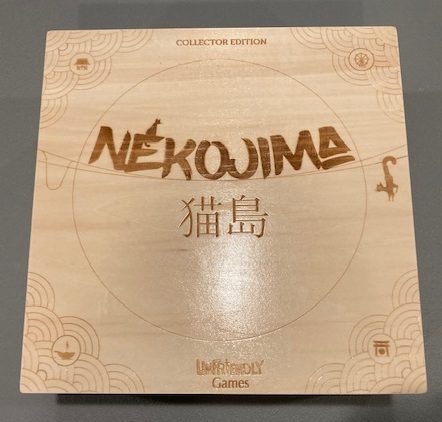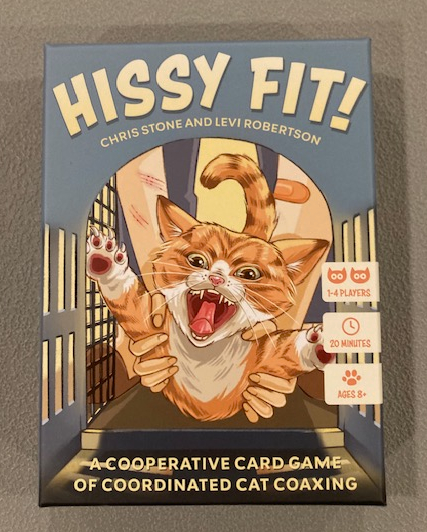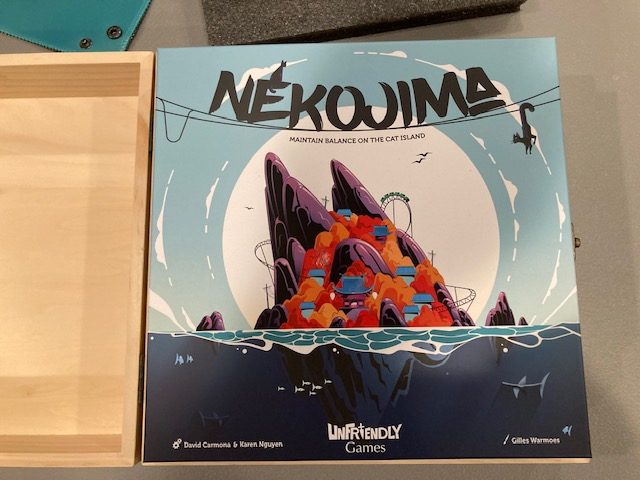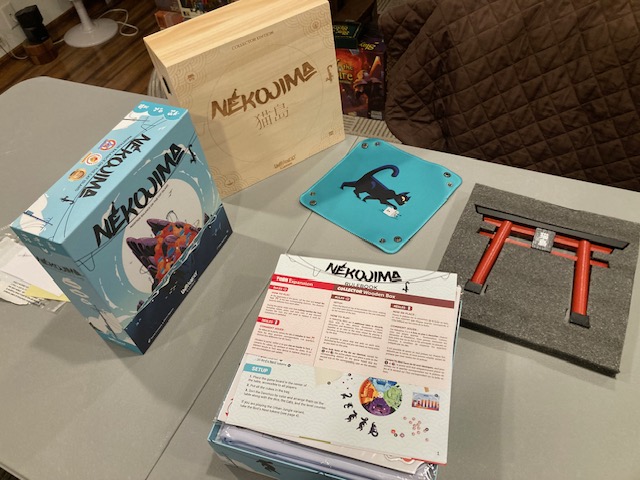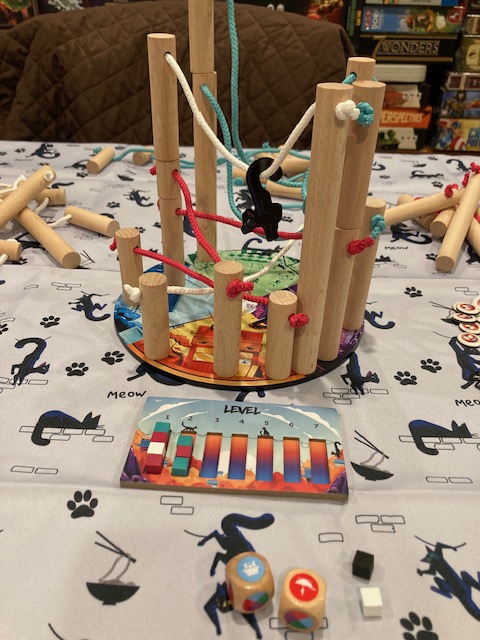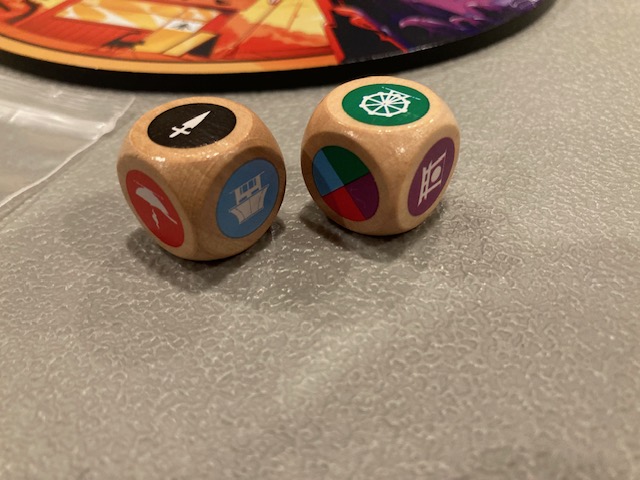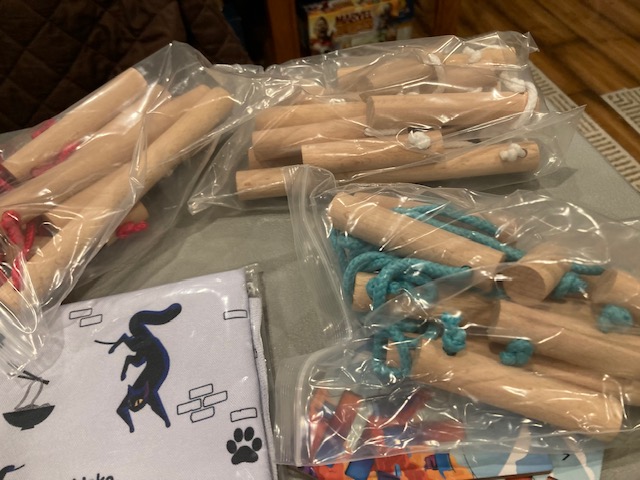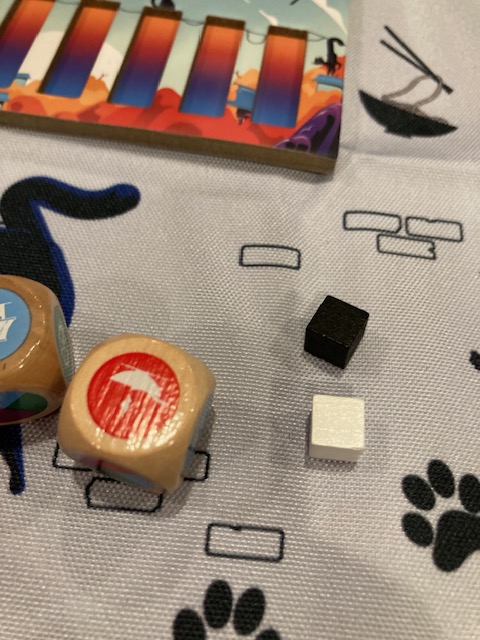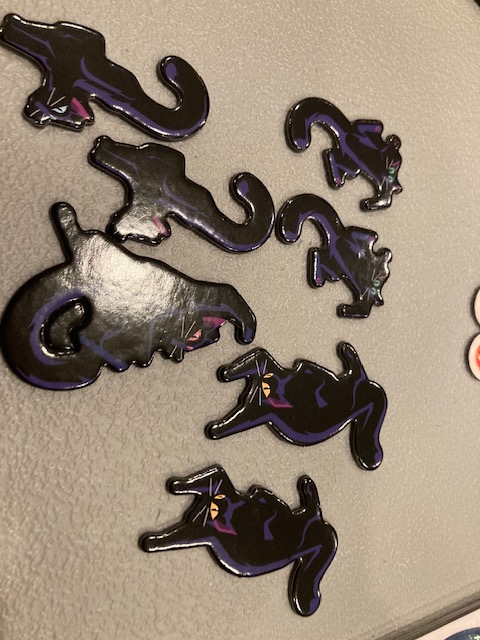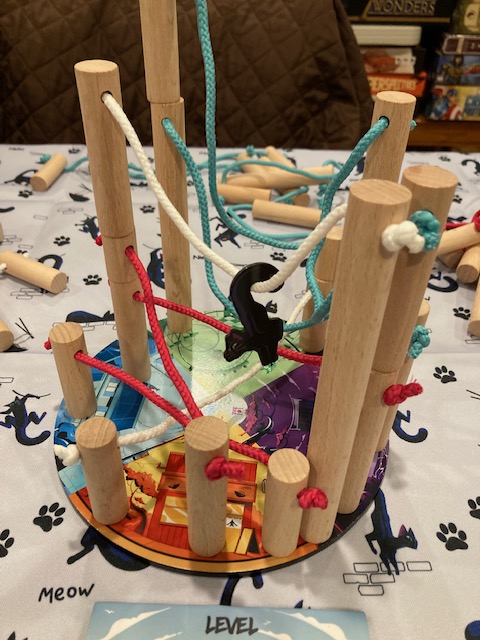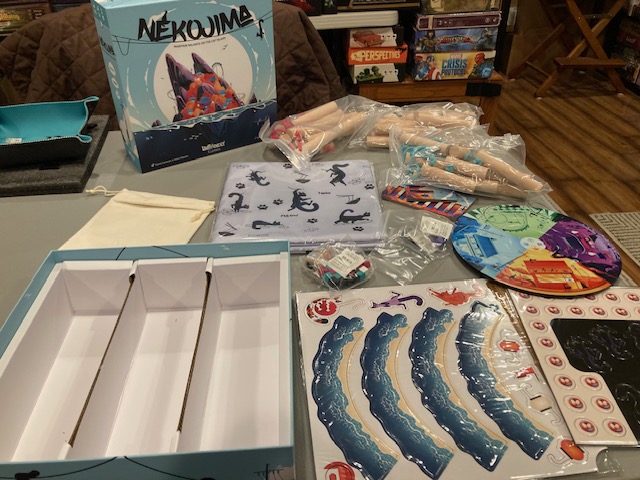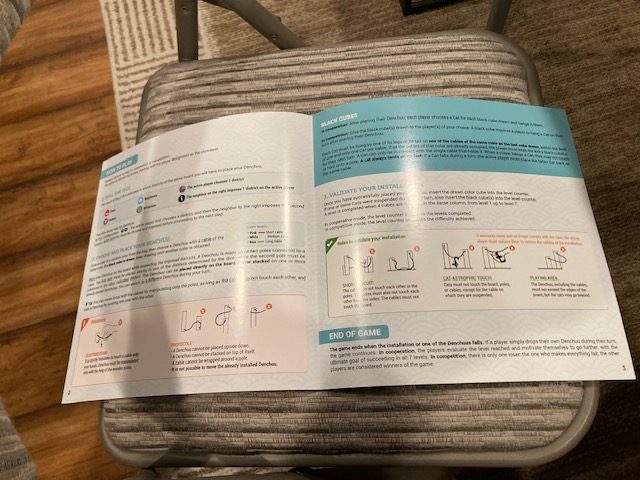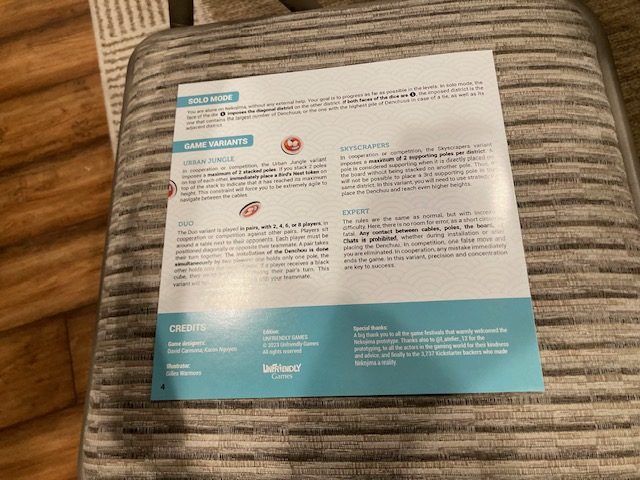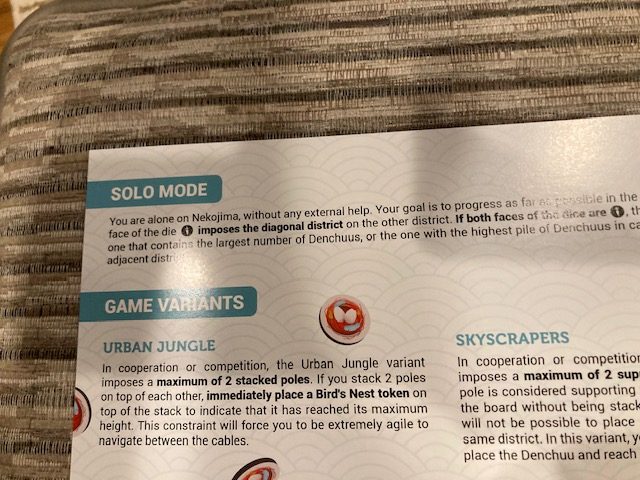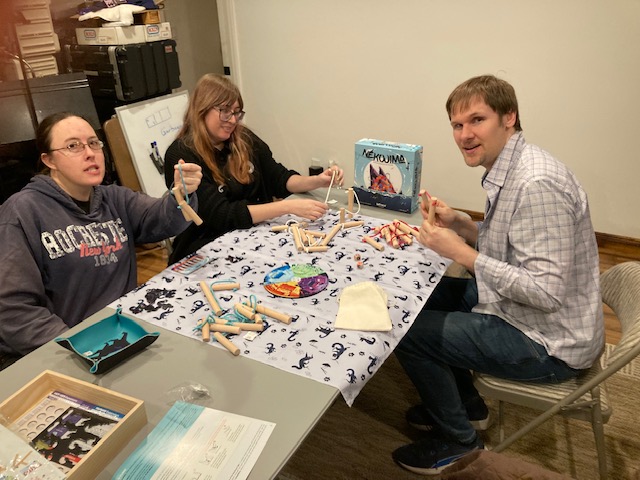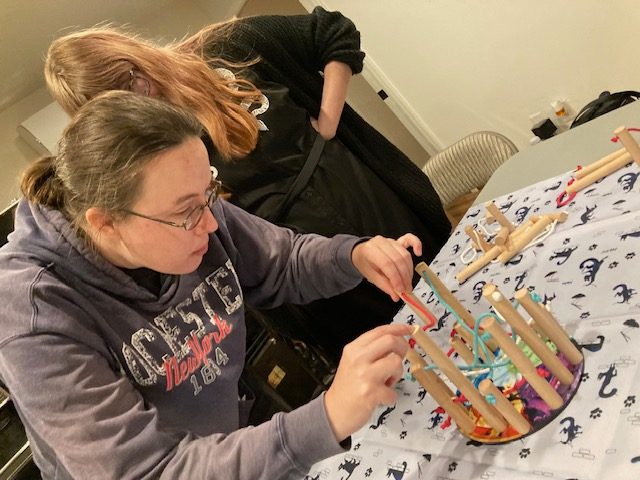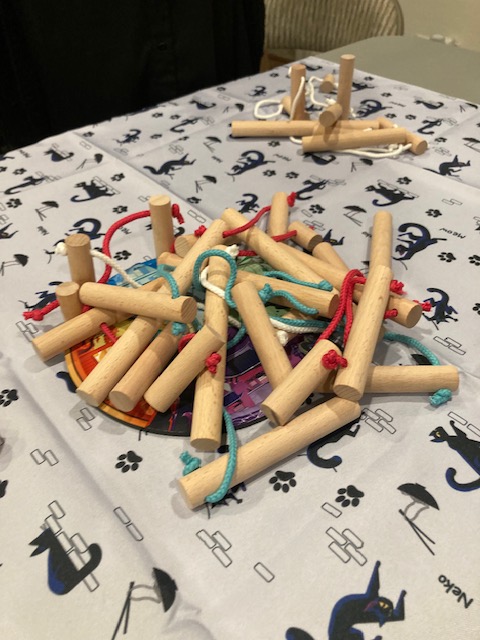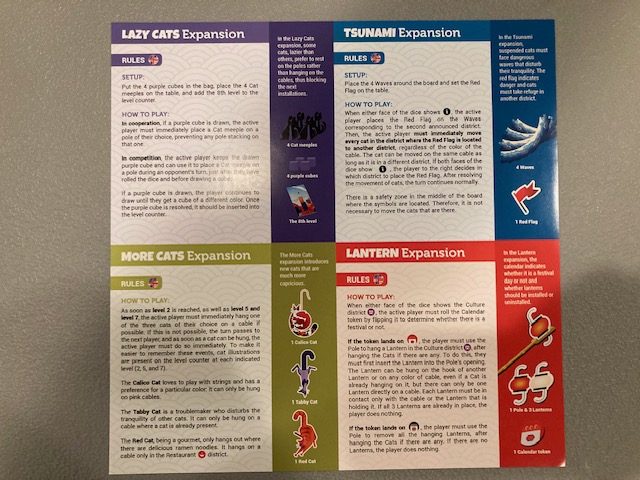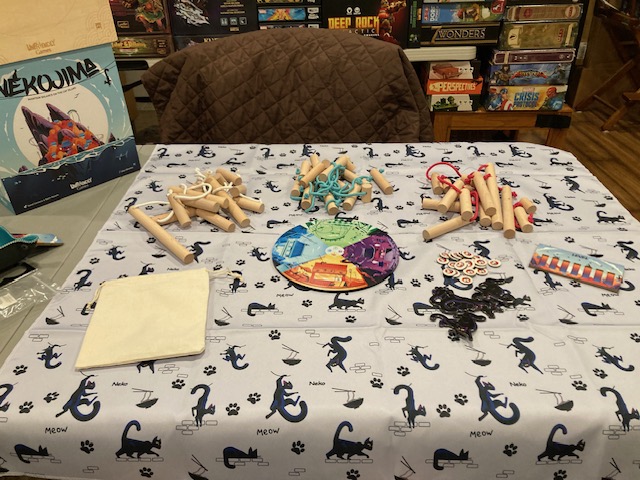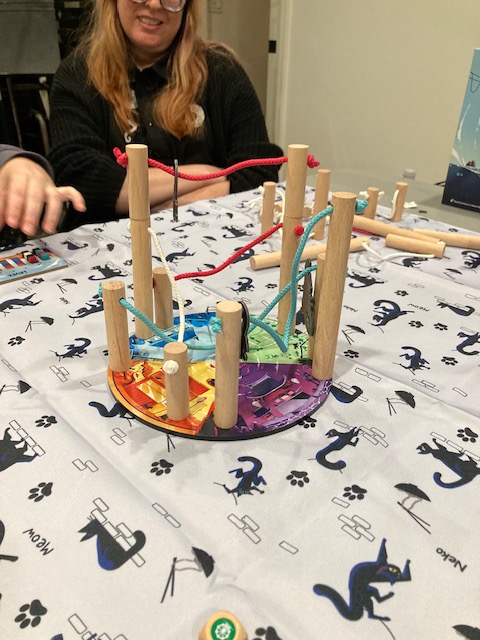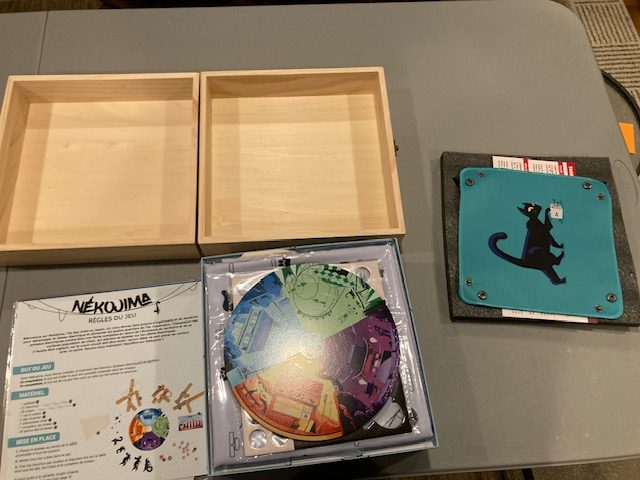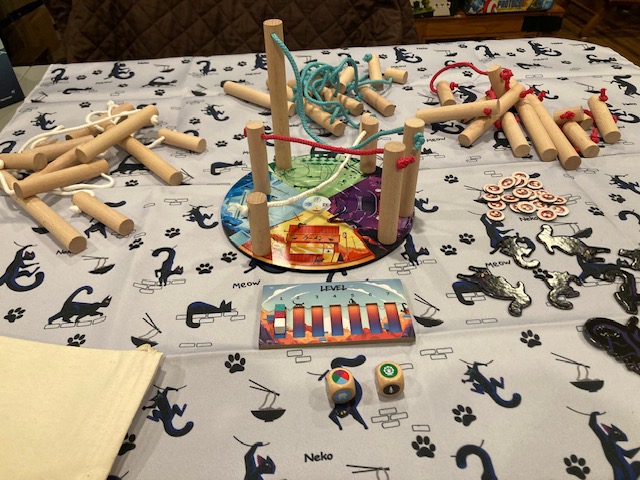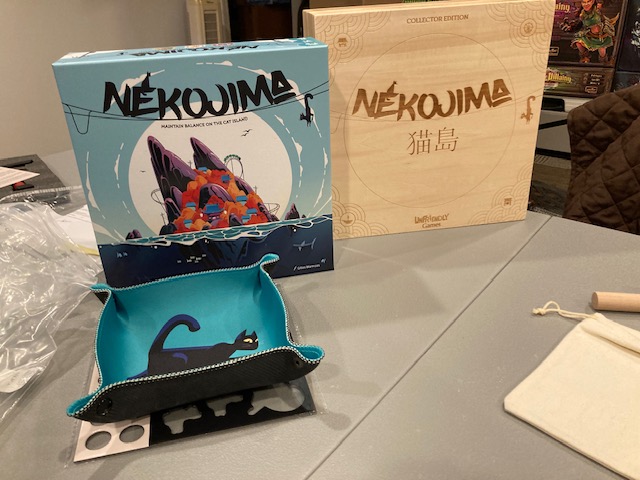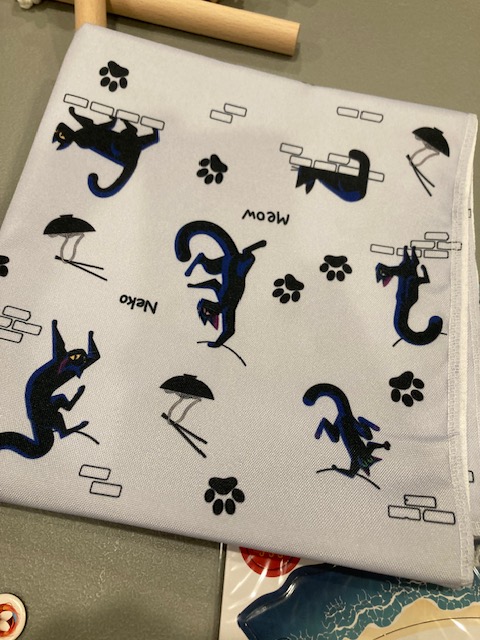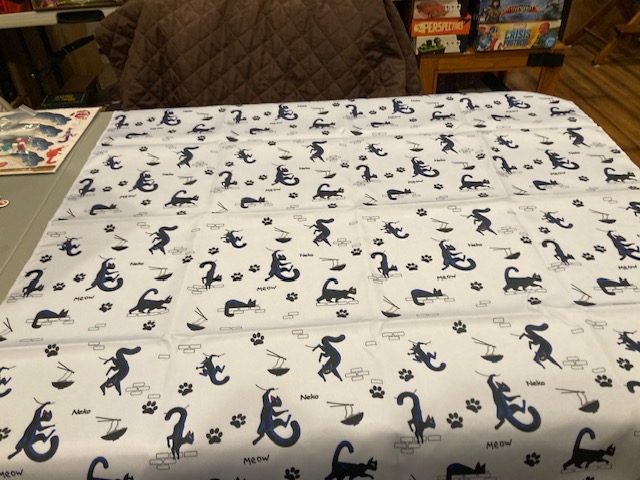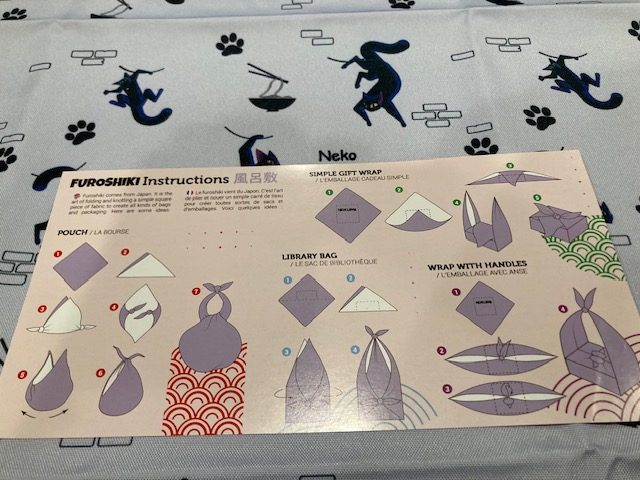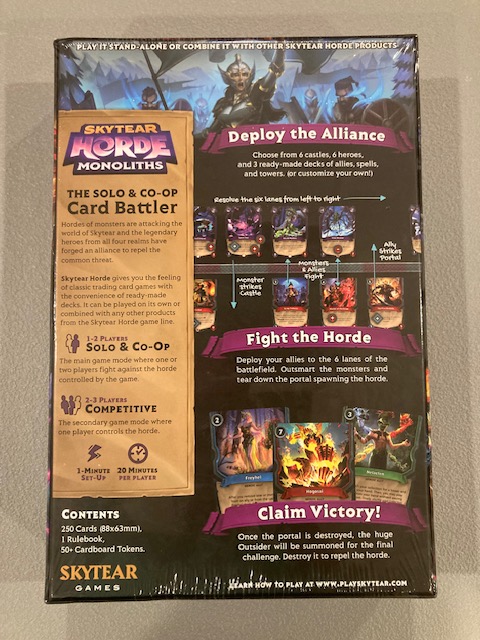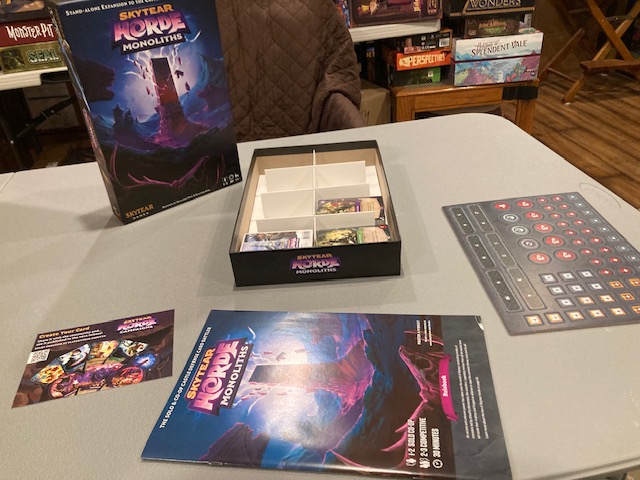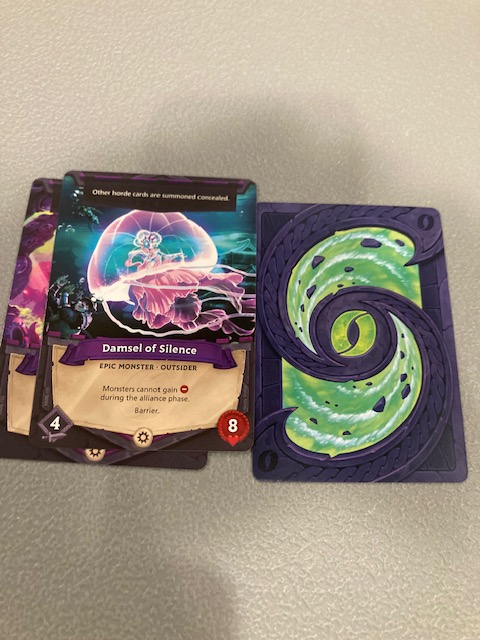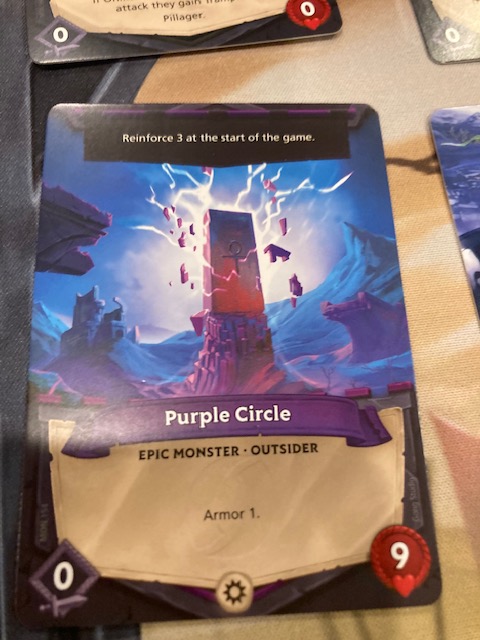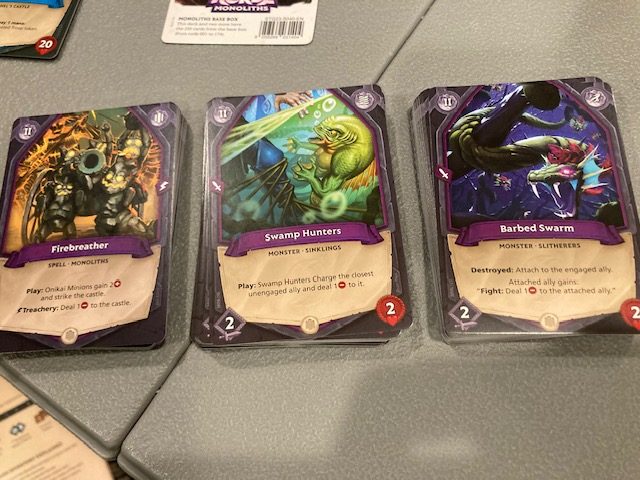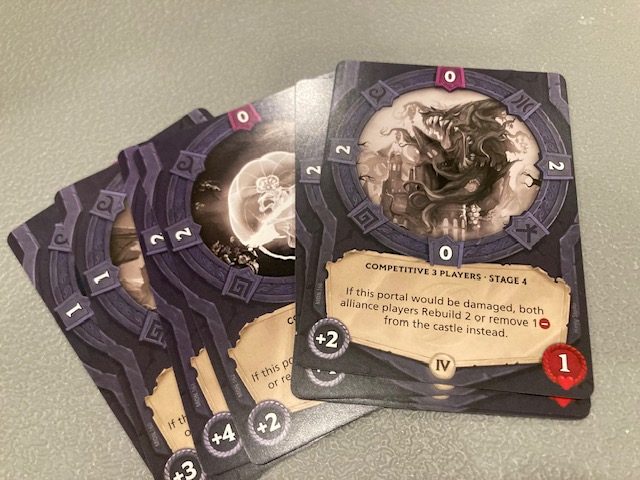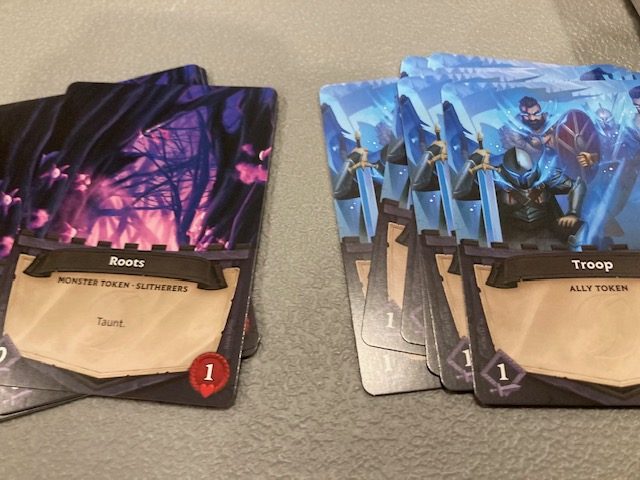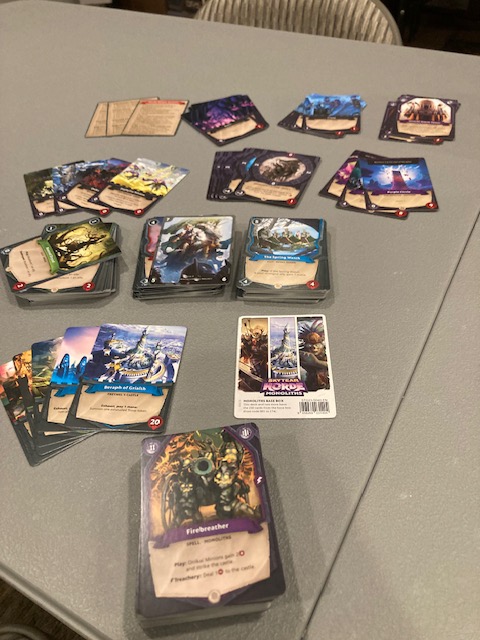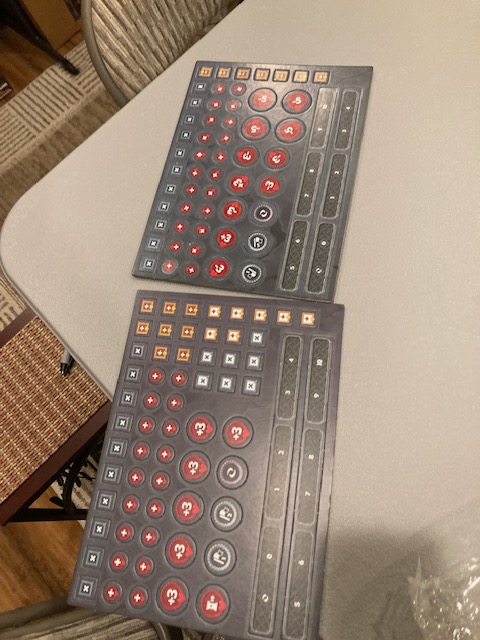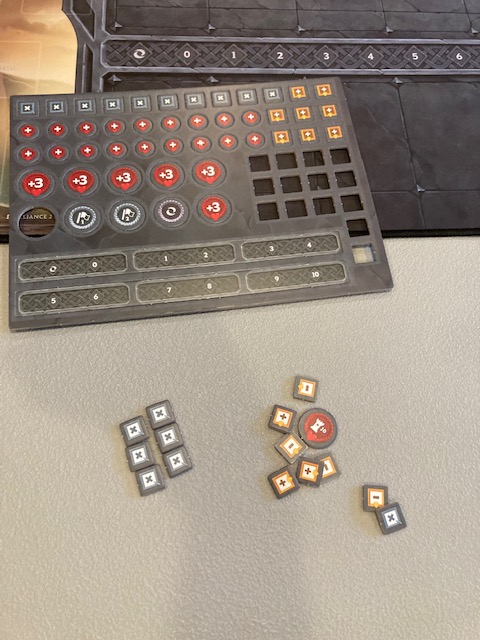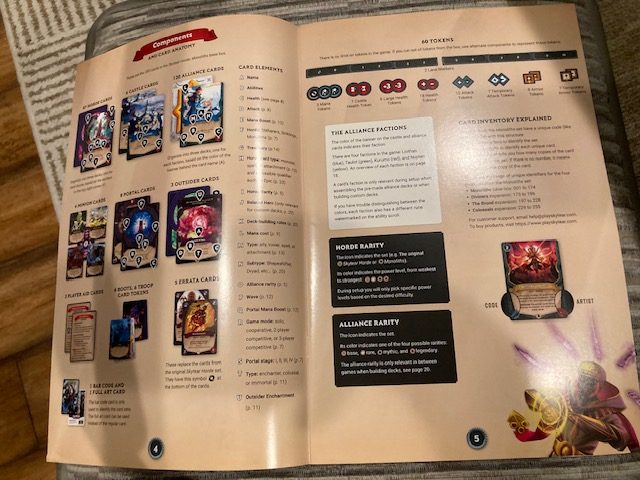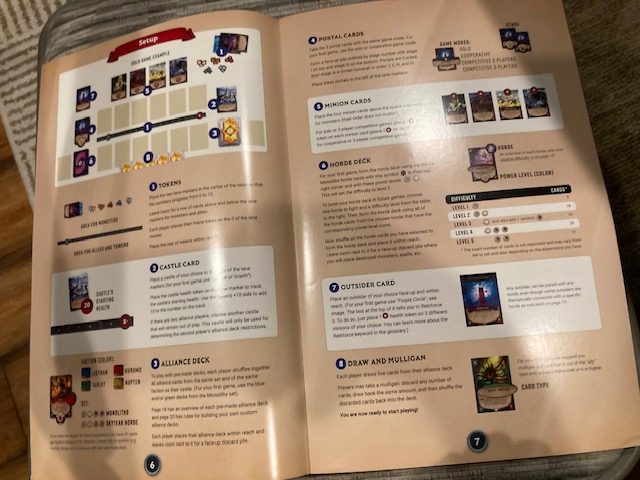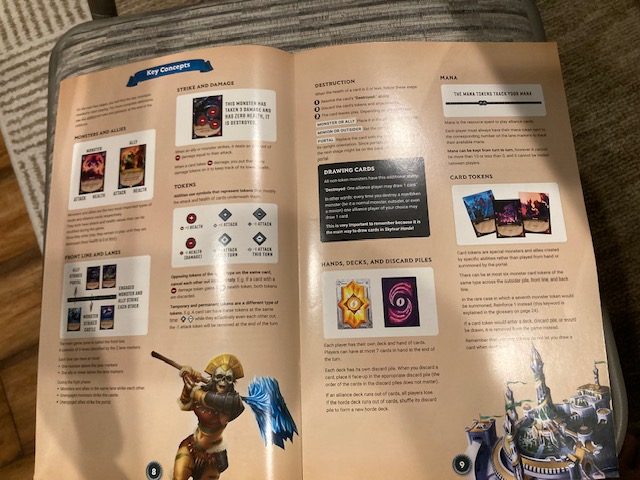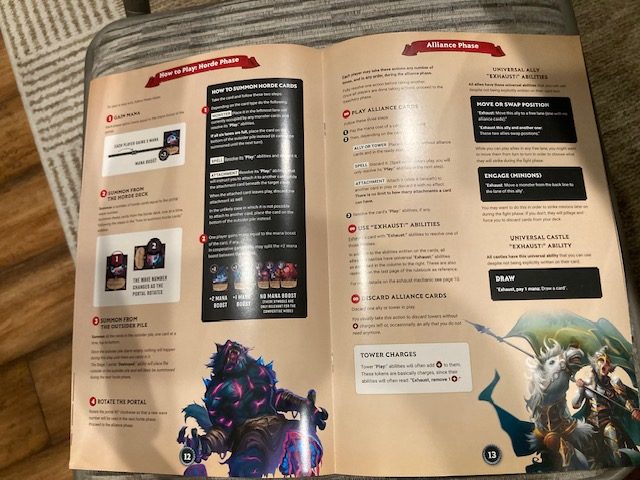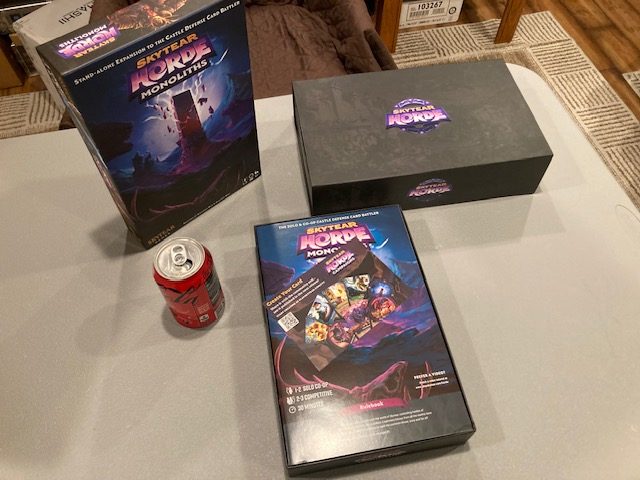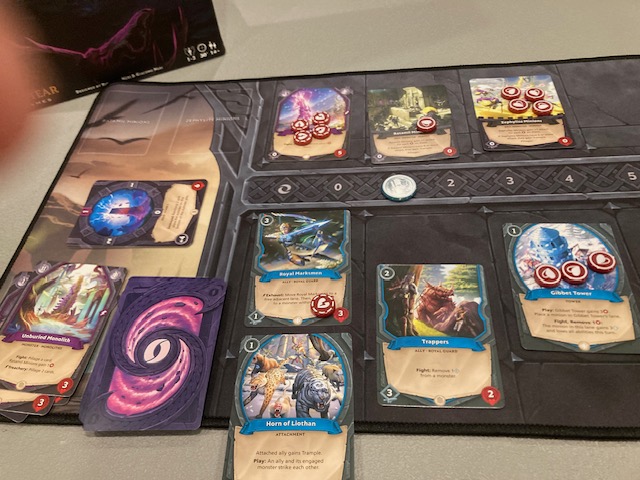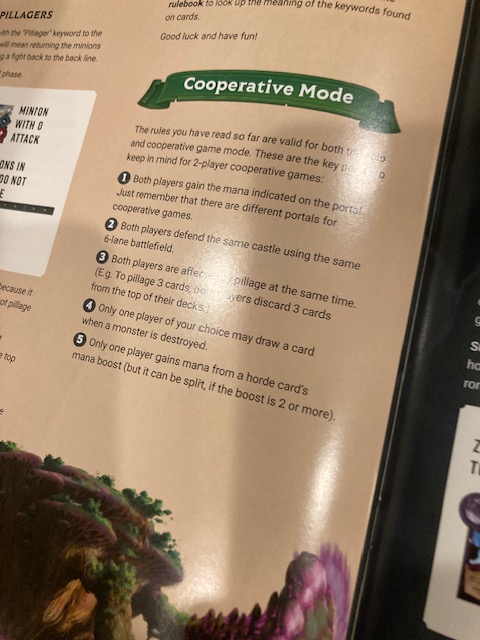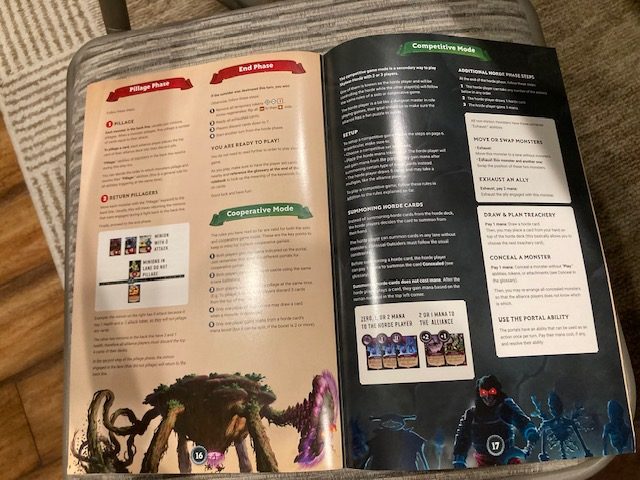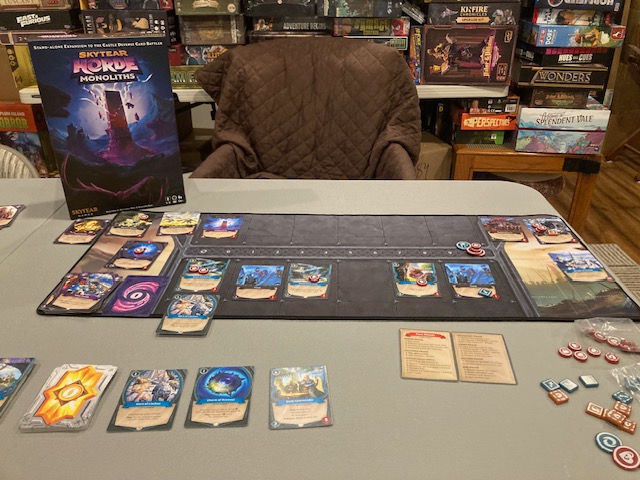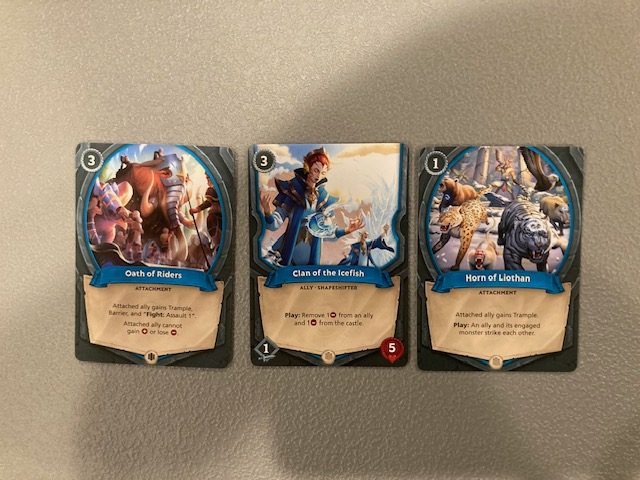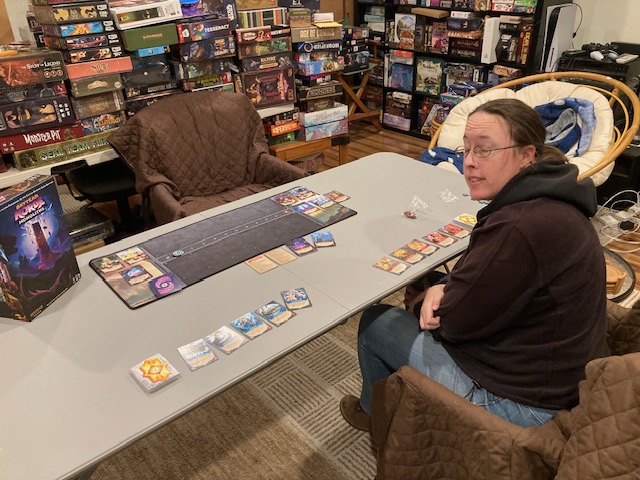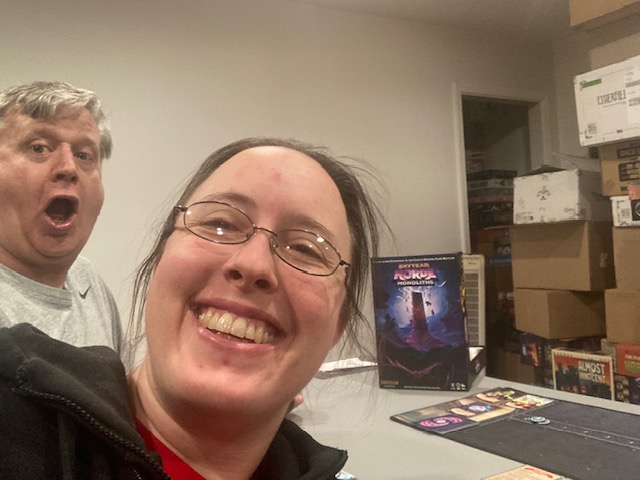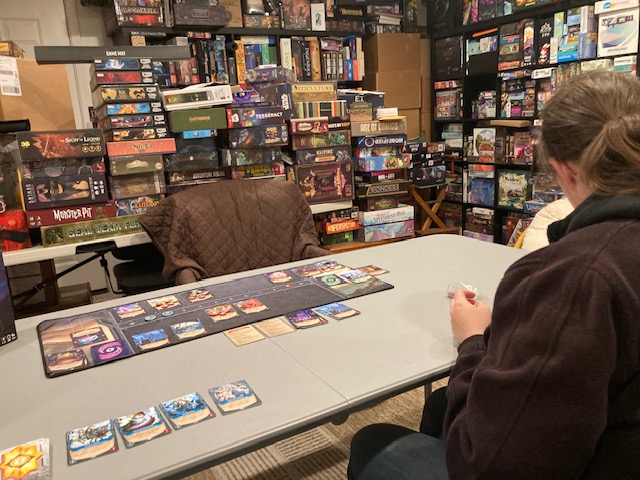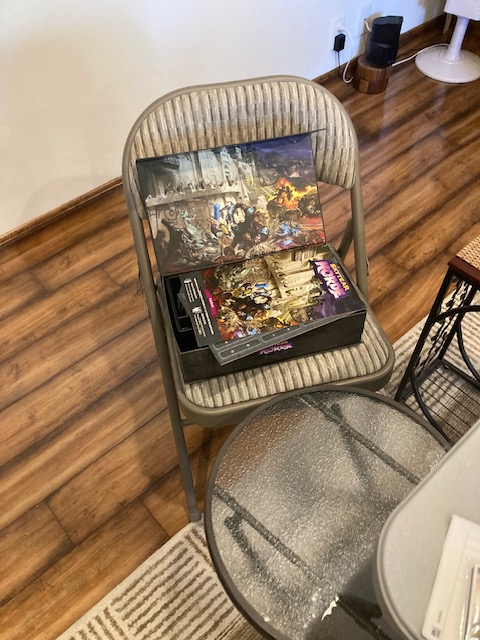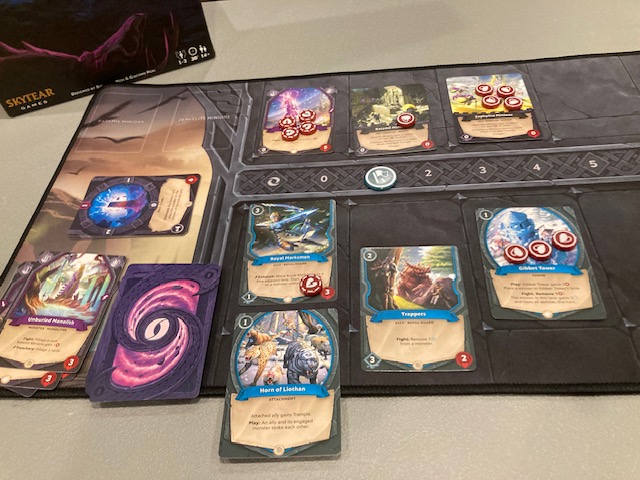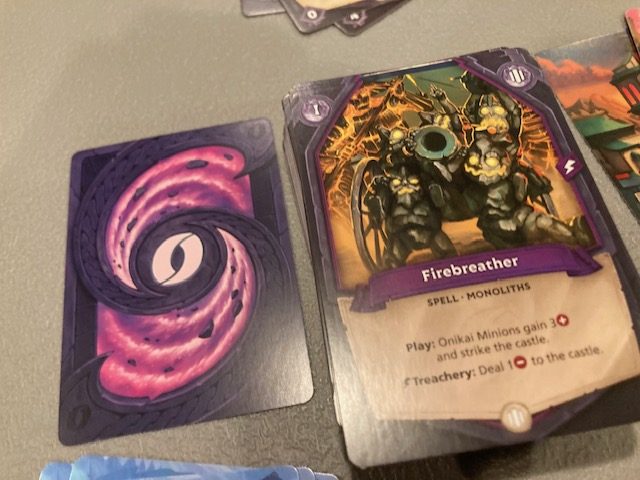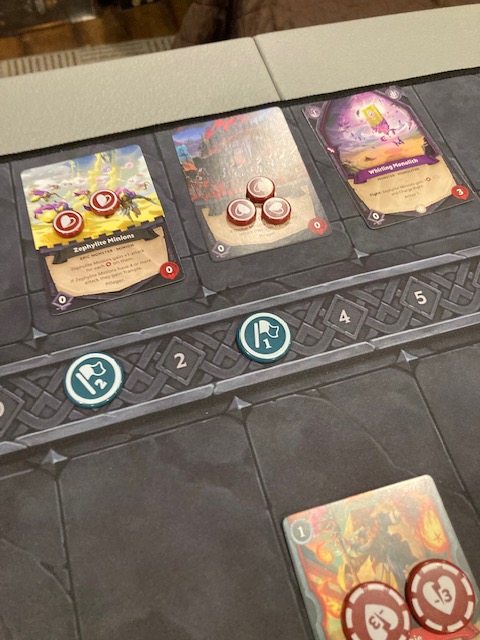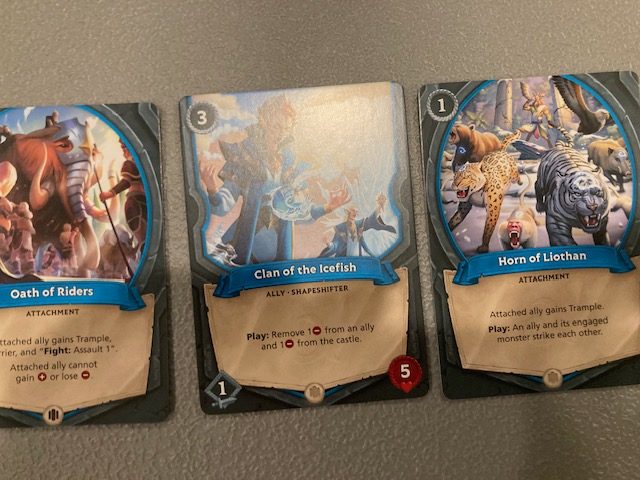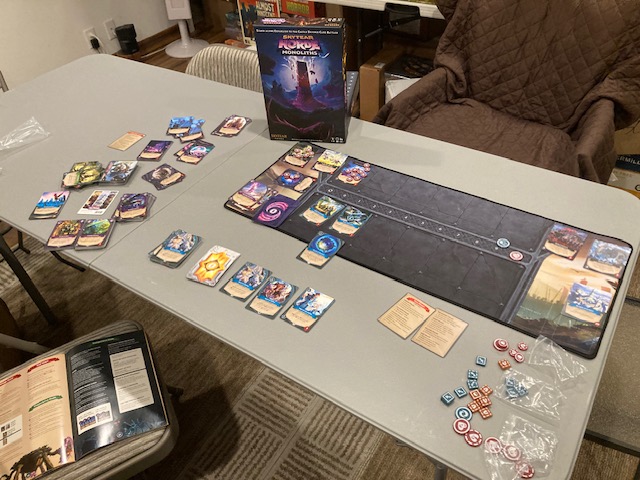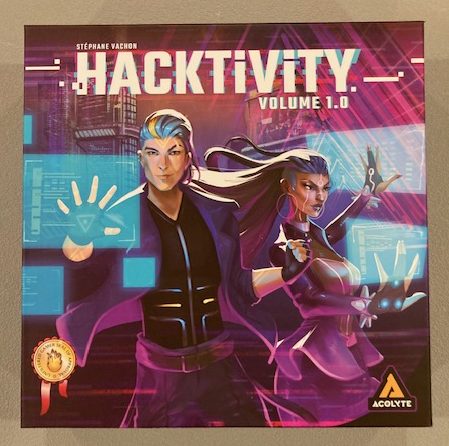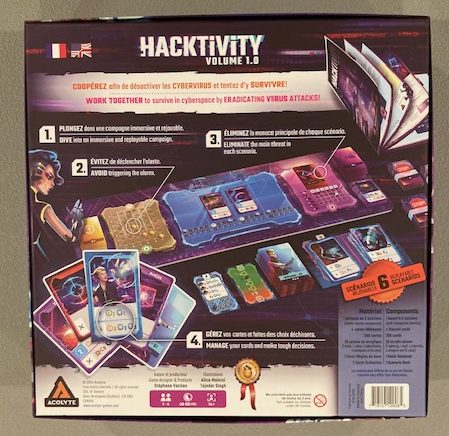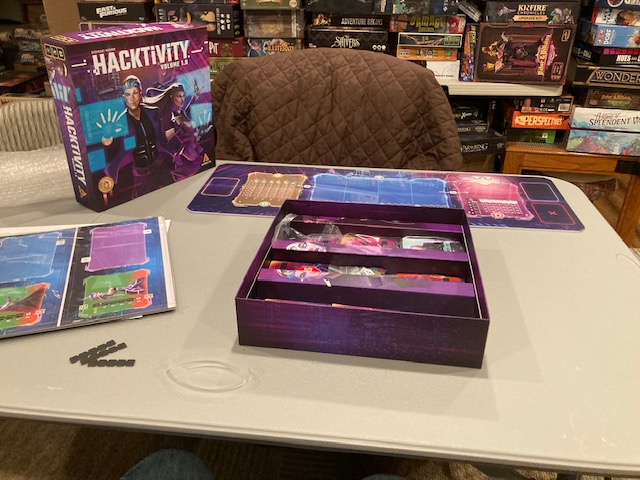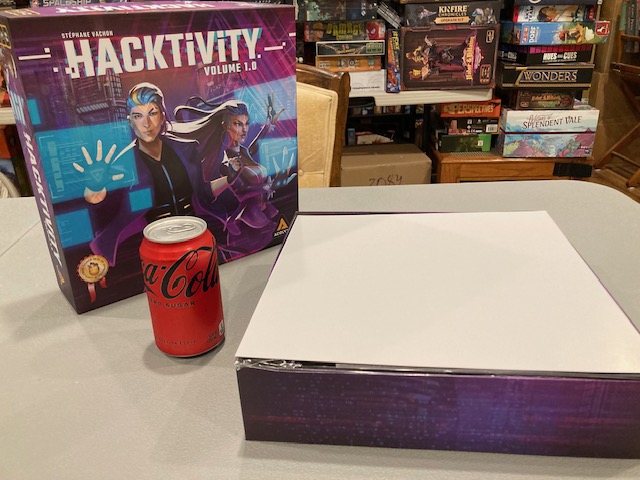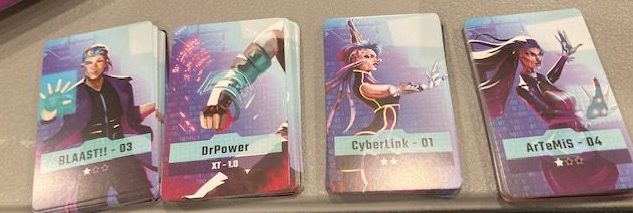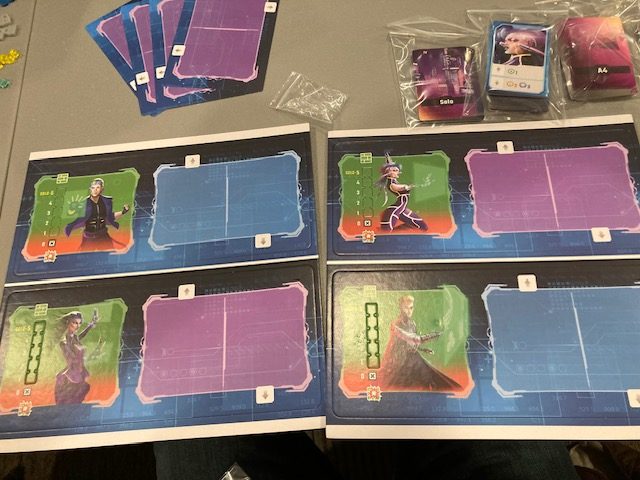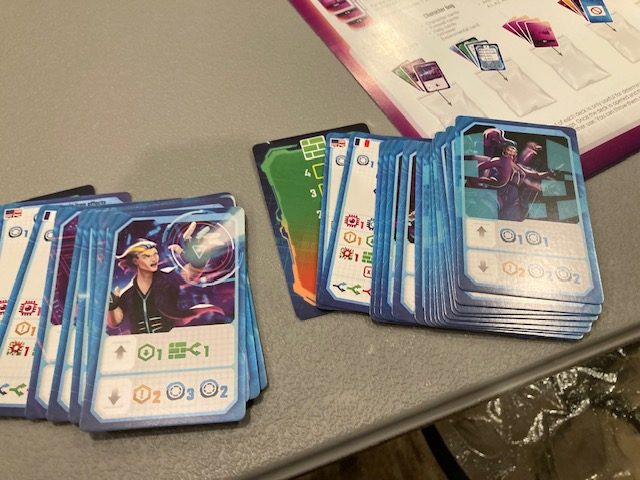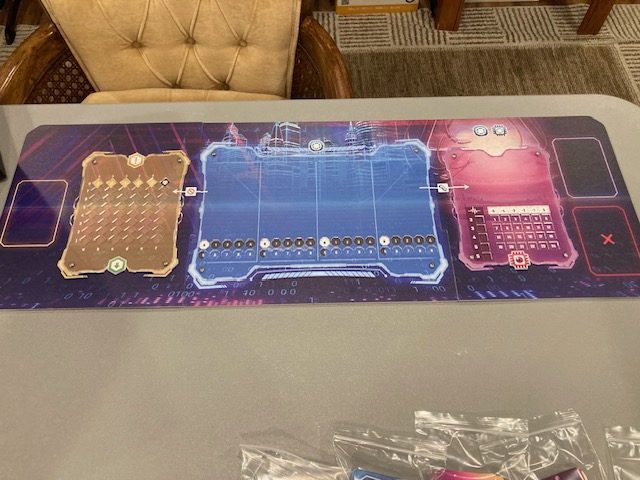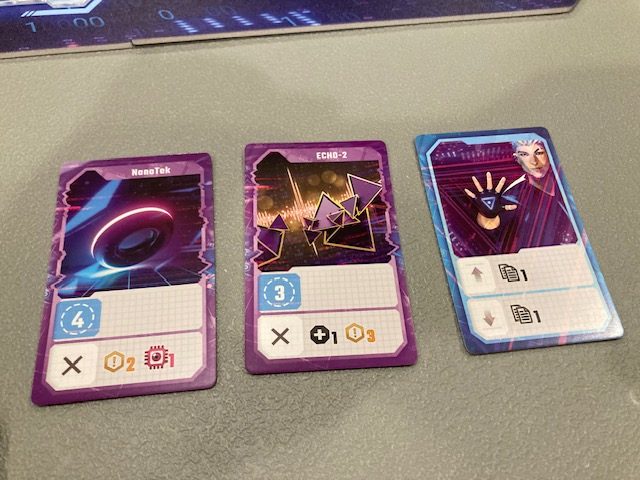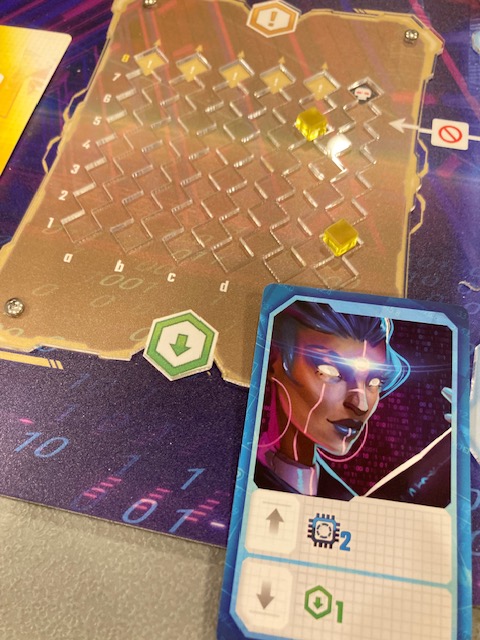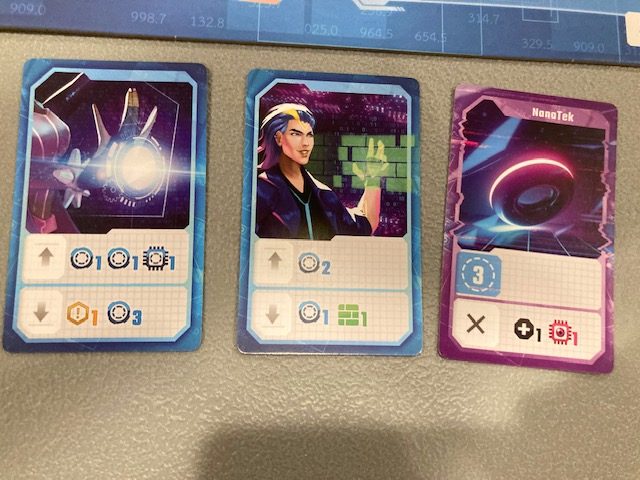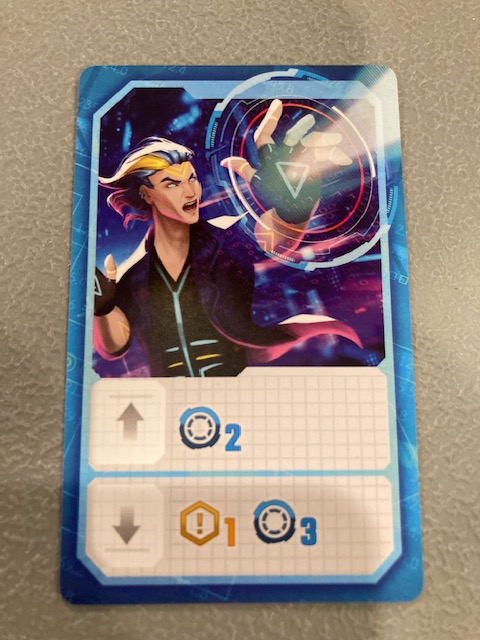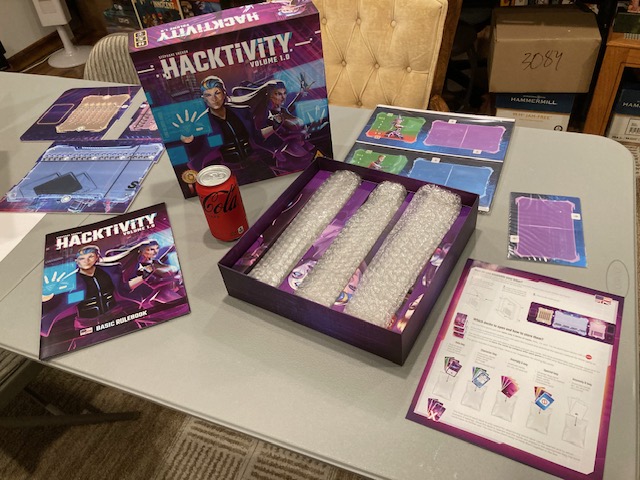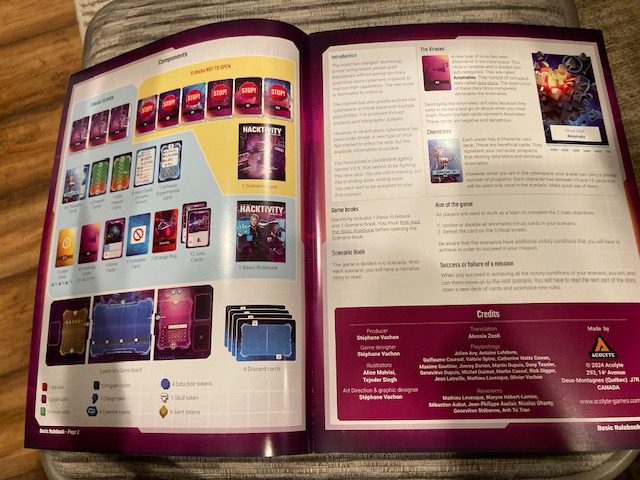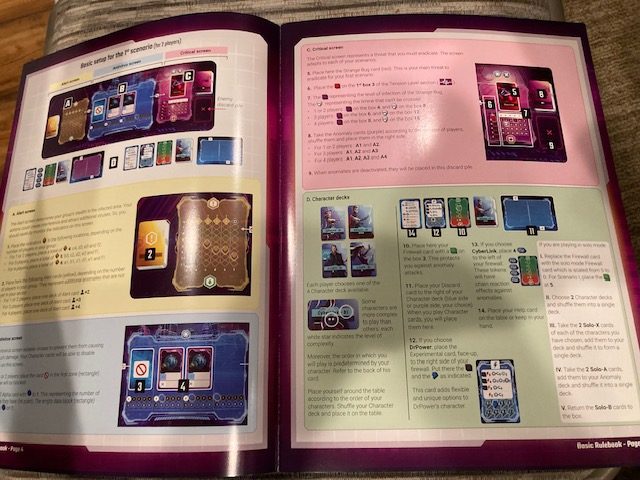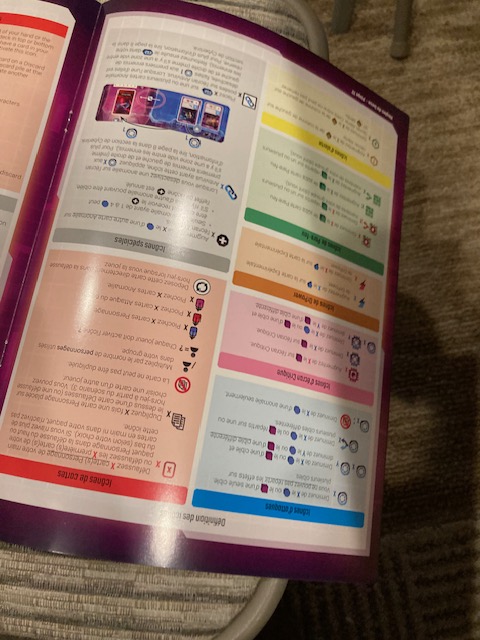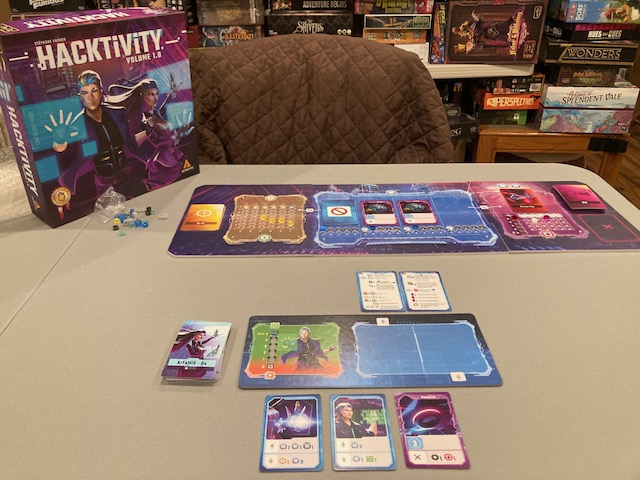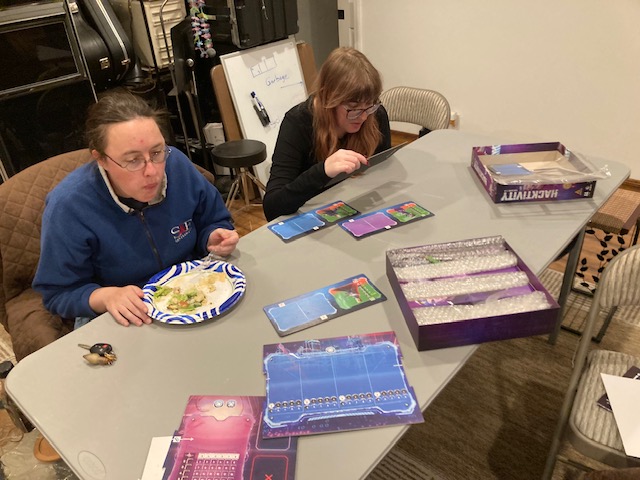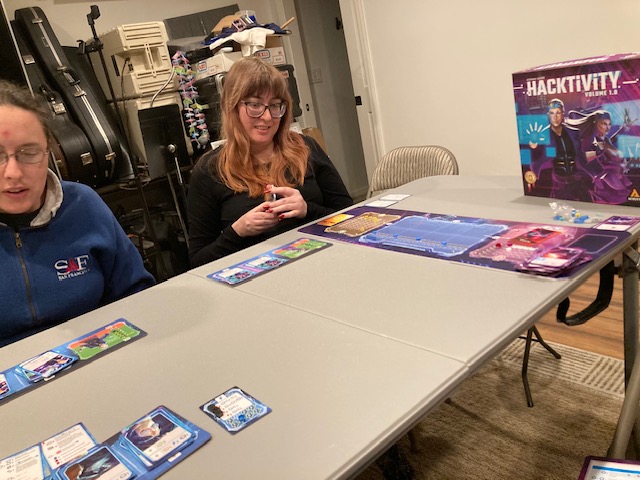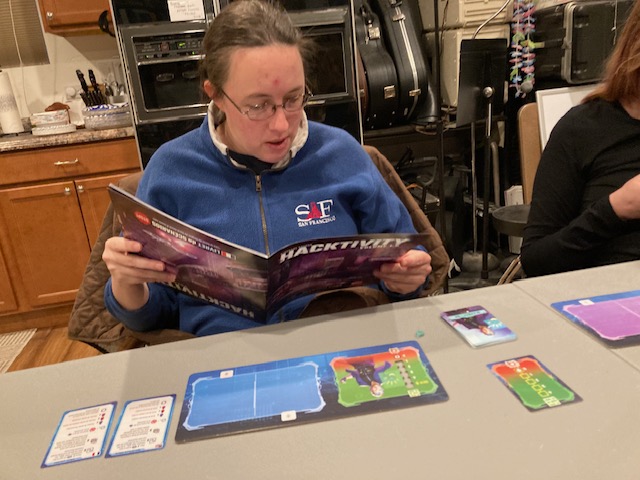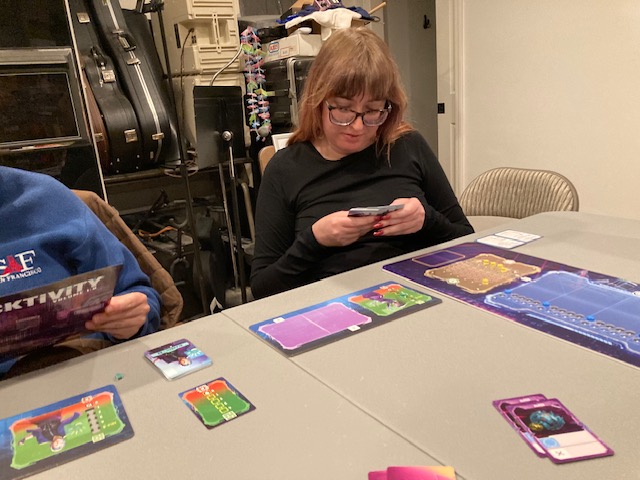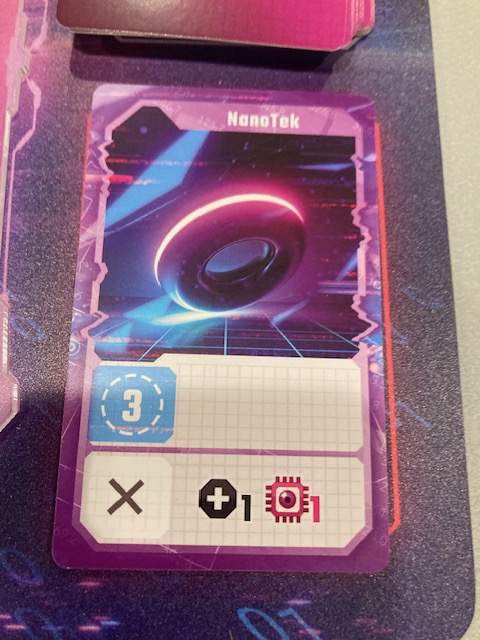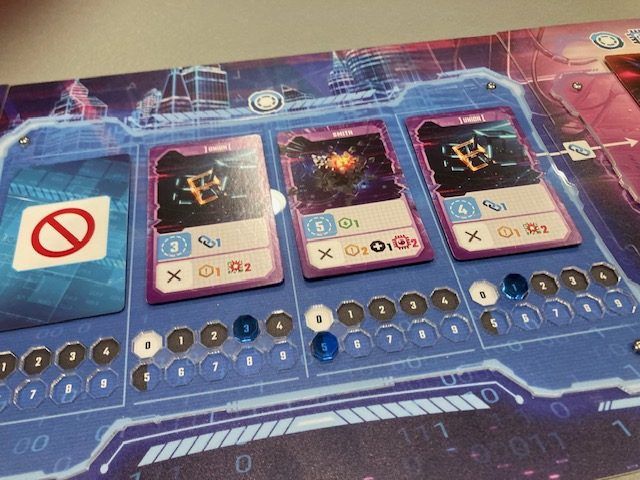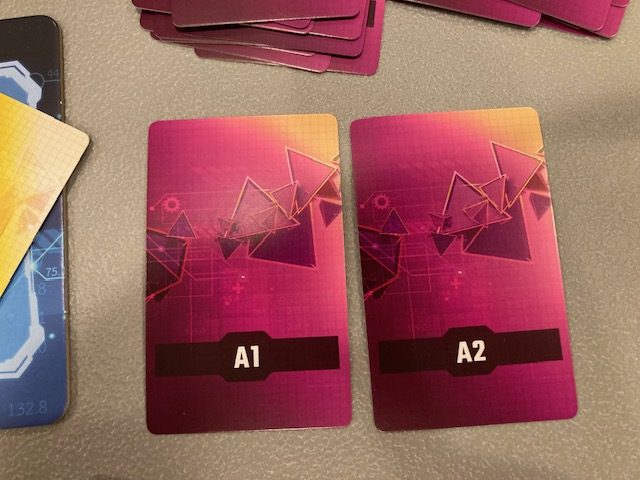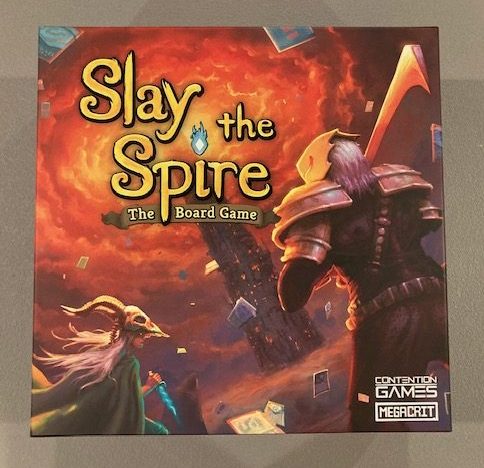
Rogue
When I was an undergrad at college, a lot of my friends played a game called Rogue on the vt100 computer terminals.
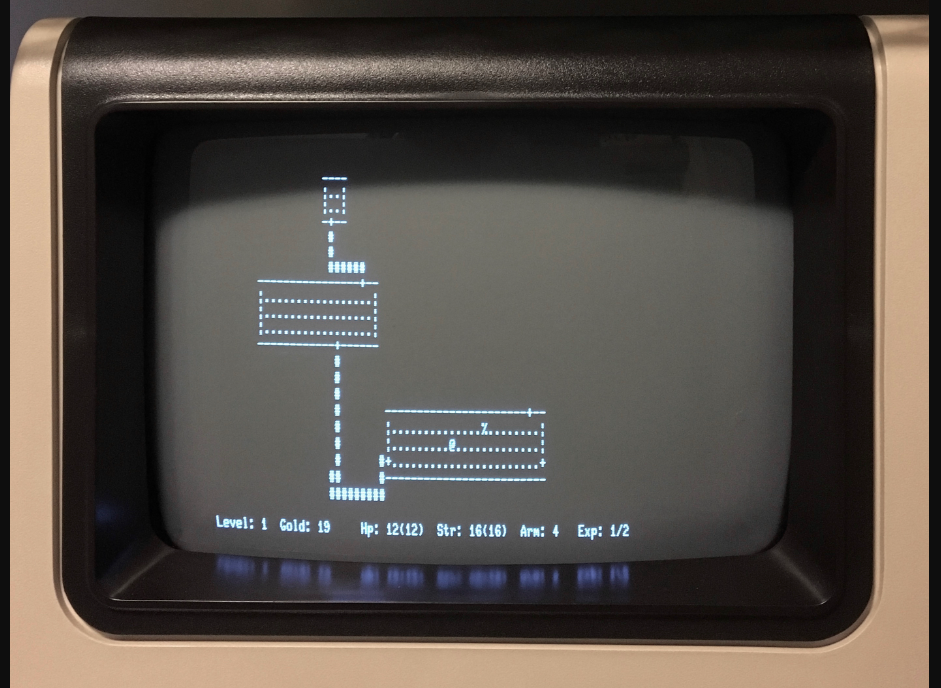
It was a little dungeon crawler that my friends spent HOURS and HOURS playing.
“It’s a Dungeon Crawler? Fun! Do you save you characters very often?“
“Uh, … no. You just play until you die. You don’t save characters.”
“I’m out!”
And that was pretty much where I learned to dislike Rogue-like games. If I play a dungeon crawler spending hours leveling up my character, I want to save it! Part of the fun, for me at least, is returning to my character that I’ve invested in. I have no desire to play a formless character that just dies.
To be fair, my opinion has not aged well. I have been informed by many people that Rogue-like games have some saving capability. Still, my malformed opinion has persisted through the years.
Slay The Spire

Because of my prejudice against Rogue-like games, I have never played the original Video game Splay The Spire. I must admit, though, that I was intrigued by Slay The Spire (a cooperative deck-building game) when it appeared on Kickstarter back in November 2022. The original Slay The Spire video game was really only a solo game … maybe the transition to cooperative board game would make it something more up my alley?
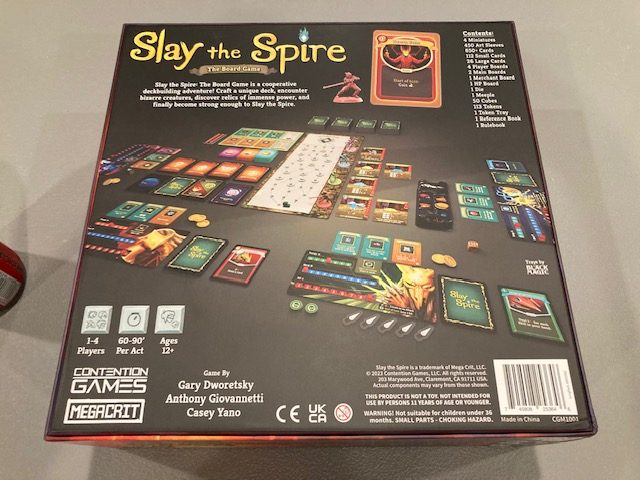
This arrived at my house in May 2023 (see above); it had promised delivery in Dec 2023, so it’s about 5 months late. In the world of Kickstarter, 5 months late is not bad.

This is a cooperative board game for 1-4 players, Ages 12+, with only 60-90 minutes per Act! I was intrigued! To be fair, a lot of my friends seemed “excited” to play this game, so I freely admit that their enthusiasm was contagious.
Let’s take a look!
Unboxing
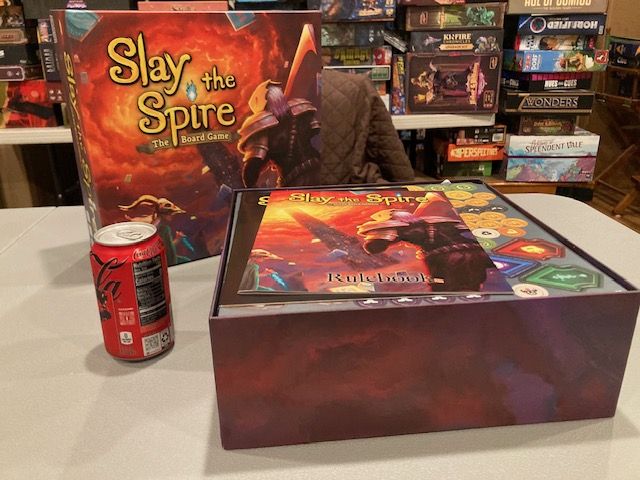
This is a pretty tall box (see Coke can above for perspective), but it’s about the same form factor (in length and width) as a Ticket To Ride size box.
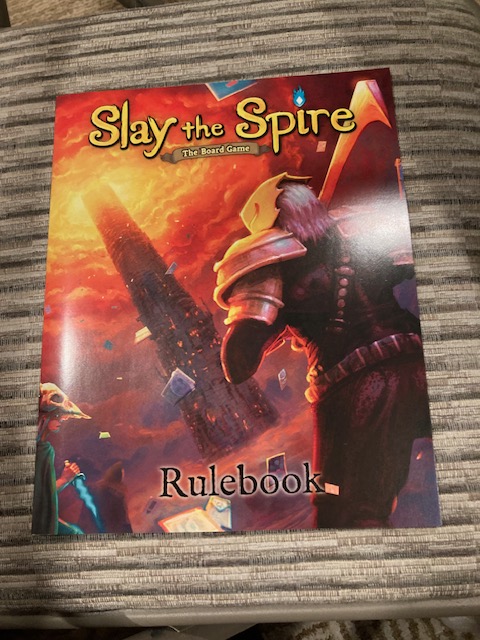
The top of the box has the rulebook and Upgrades and Items guide.

Don’t be too impressed by this Upgrades and Items guide: all it does is show all the cards! It has no disambiguating text!

There is a very nice boxing/unboxing guide for putting this together and taking this apart. See above.
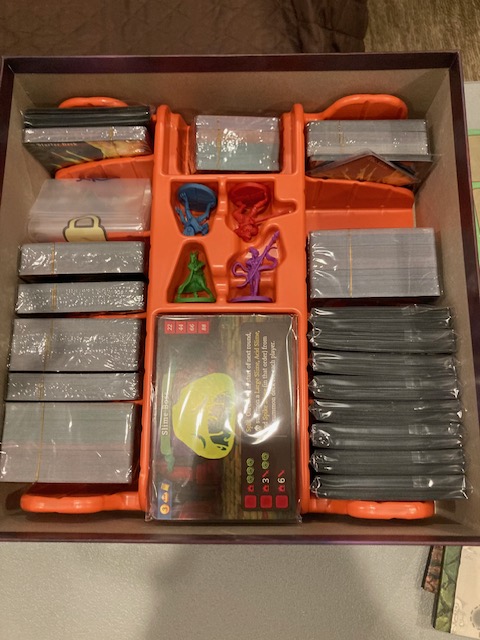
Are you like me as one of the few people and didn’t know that Slay The Spire Video Game was a deck-building game? Well, the board game is also a deck-building game! As a deck-building game, this game comes with SO MANY cards! See above and below. And its own sleeves! For more discussion of Cooperative deck-builders like this, check out our Top 10 Cooperative Deck-Building Games!

I have been informed that the cards and art look exactly like the Video Game.

And there are a ton of cards and boards! See above! This game looks really fantastic! See above!
And it looks like the Video Game.

I want to be 100% clear about this: this production is amazing! It’s a deck-building game that comes with sleeves! The tokens come in an easy-to-use tray! The cards can all be stored very easily in the box! The box is easy to repack! They really knocked it out of the park on the production of this game!
Gameplay
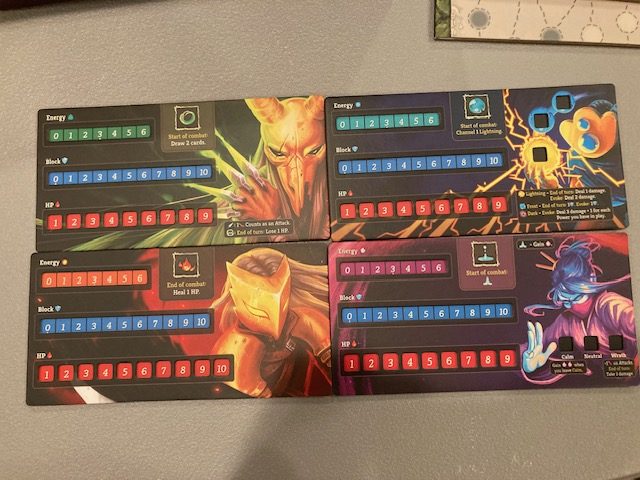
Each player chooses one of 4 characters to play: see the characters above. I have been informed by players of the Slay The Spire Video Game that these are straight out of the Video Game!

Each player also takes the corresponding figurine: these will be used to notate which “row” you will be fighting in; we’ll describe that more below.

Each player has their own deck of cards to start with: each deck is a little different and really represents a different play style. Simplifying a little too much: the blue deck is defensive, the red deck is offensive, and the green deck is all about poison.
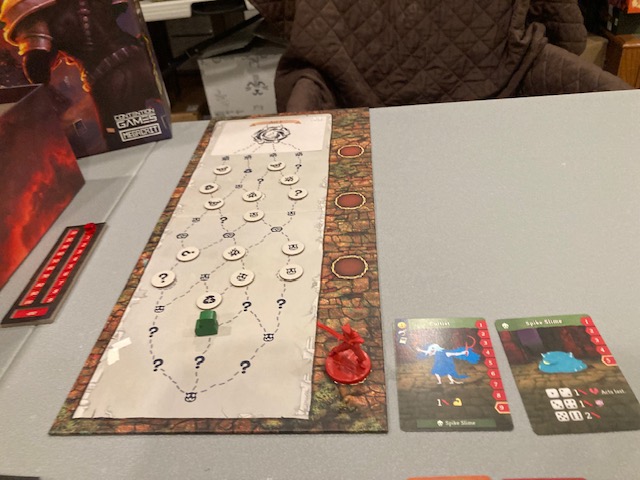
Players together choose a “path” to take to get to the final Bad Guy (at the top of the board above). These decisions can have you fight a monster, summon the merchant, build a fire (“smith” or heal: I learned the word “smith” from one of the Slay The Spire Video Game friends), fight Epic monsters, or take events. I was informed these choices were very reminiscent of things that happen in the Video Game.

When you fight a monster, each row next to a character gets some monster(s) from the Encounter Deck! See above as “the red guy” fights a Shelled Parasite. (I don’t know “the red guy’s” name because it is not notated on his board). Note that the monster has some hit points (left and right of card), and some icons: those icons tell you what the monster does when it attacks you.
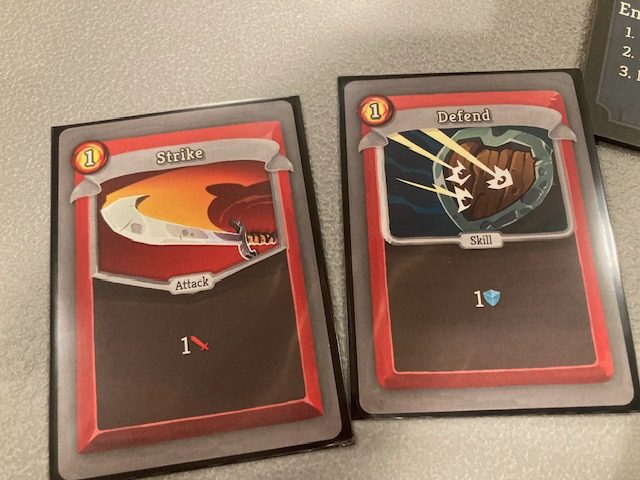
As a card game, you play cards to attack your monster and/or defend yourself!! Shields up your defense (blue icons above), and swords up your attack (red swords above). You only have a limited amount of energy per turn to spend to play a card (usually 3 energy worth), so that limits which cards you can play (the energy cost is in the upper left corner).
You draw up to 5 cards every turn, and discard all when you are done. That feels very much like a deck-builder.
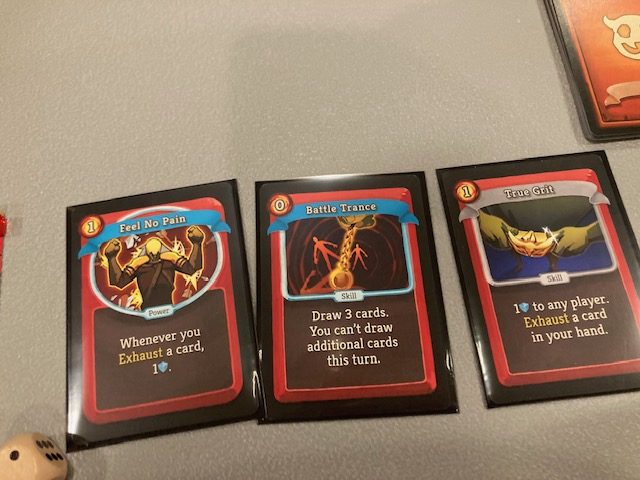
Typically after you win a battle with a monster, you can add an upgraded card to your deck: you deal 3 and choose 1 (apparently, just like the Video Game). See an example draw above.

See above as some of my cards have a GREEN text for the title? This means that I was able upgrade the card BY FLIPPING IT OVER! Each card has two sides, a normal side and an upgraded side: you can “Smith” to turn the card over and therefore improve it!! This is a really neat mechanic in a deck-building … and rare! I can’t think of another deck-builder that does this!
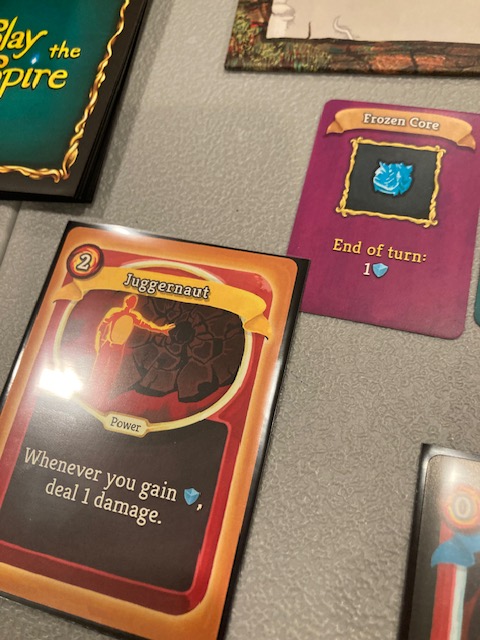
You can also occasionally get new additions from a rare deck (see yellow outline): these are much better cards!

To be clear, each character has their OWN upgrade deck to draw from and their OWN rares deck to draw from! See above: the red guy has a starter cards (grey outline), upgrade deck (black outline), and rares deck (yellow outline). This makes each character very distinct as they are built to upgrade a specific way. Like we said earlier, the red guy’s decks concentrate on attacks, blue guy’s deck concentrate on defense, and green guy’s decks concentrate on poison.
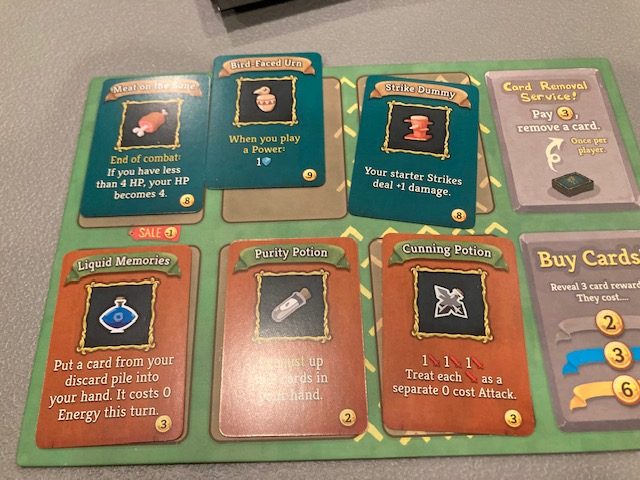
You occasionally can buy stuff from the passing merchant, including potions or treasures and even random cards. This even includes a way to cull cards: we call this The Andrew rule: A deck-building game MUST have a fairly systematic way to cull cards. Luckily, Andrew would (and does) like this game because he can cull cards.

Along the way, there are all sorts of other cards that come out: Events, Monsters, Potions, Treasures, Epic Treasures, and deck-cloggers (Daze and fire). I have been told this is just like the video game!

But of course, the purpose of all this is to take down the Big Bad Monster at the top! See above as I fight the Big Bad Bronze Automaton and a Bronze Orb!
Like many cooperative games, all players win together when they defeat the Big Bad, or they lose if any of them dies! So, it’s in everyone’s best interest to cooperate and keep each other alive!
The Rulebook

I need to talk about the rulebook. It’s okay, but not great. It really should have been better given how great the production of the rest of this game.

It does well on The Chair Test: it only droops over the edges a little, the font is big and readable, and the book stays open on the chair next to me so I can see the rules without taking up precious table space. This rulebook gets an A- on The Chair Test!!
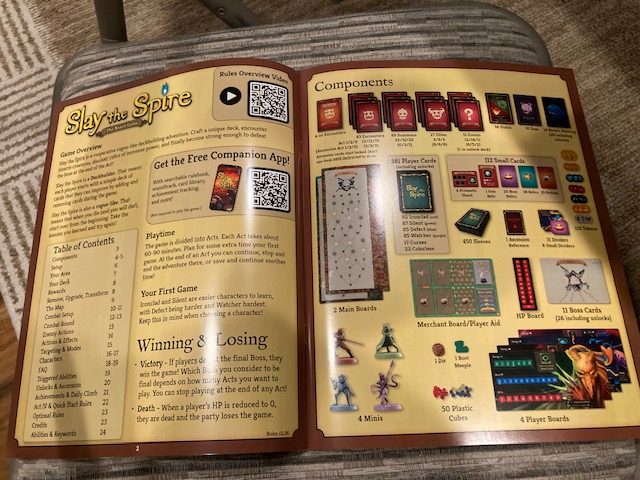
The game starts off great with a Table of Contents, a link for a Companion App, a link for a How to Play video, and a list of all components (most) with correlating pictures!! Very very nice! I felt very happy to see this! My only fix might be that I had wished they had labelled the tokens better … there are a lot of tokens and I didn’t know what any of them were!!

The set-up is pretty good, but this where the cracks start to develop. This is my first example of this rulebook being too minimal: I accidentally shuffled the Summon deck, but it doesn’t say WHY you shouldn’t it! I didn’t know how to recover?!?!??! It turns out the Summon deck should “probably” just be alphabetically sorted so you can find cards easily … that’s the only reason to not shuffle it, you just make your life harder when you have to find a card. Really, I could have used a sentence:
“Don’t shuffle the Summon Deck because you will be searching for cards (alphabetically) in it later in the game. Just sort the deck alphabetically if you accidentally shuffle it!
But other than that, the set-up went fairly well.
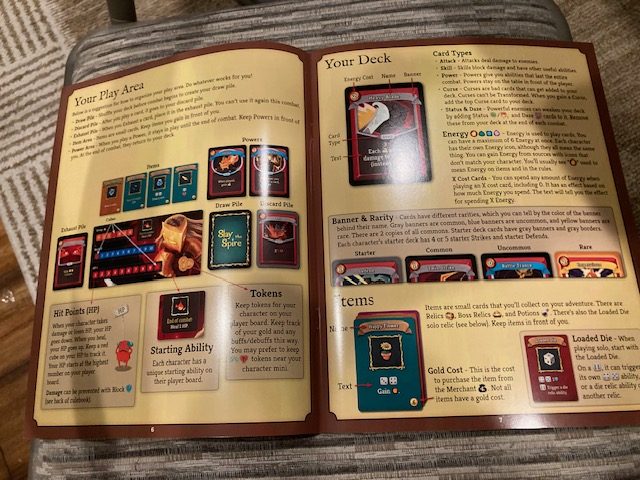
This rulebook is pretty well annotated with lots of pictures and examples. See above. In general, the rules are fairly clearly set out. But the real problem with this rulebook is that it seems to assume that you have played the video game. There are a lot of places where a rulebook for a normal game would be chastised. I can’t tell you how many times I played with Jon and Keala (who have played the Video Game A LOT), and when I went to lookup a rule, they told me “it’s just like that in the video game! So it probably means that!” So many times, they clarified a rule by saying “it’s like that in the video game!” … which is not good for those of us who haven’t played the video game or other Rogue-Lites.

My canonical example of this was the Regret curse. I actually got two curses one one turn, Regret and Injury (see above)! My reading of these was that Injury was a worse curse because it keeps clogging my deck as I draw it and shuffle it back in. I though Regret was a better curse because you just got once and it was out of your deck. Nope! It clogs your hand so you draw fewer cards! You draw up to 5 cards, so if Regret is in your hand, you can only draw 4 cards. I didn’t think the rule was well-specified in the rulebook, but when I asked Keala and Jon they said “Oh it’s just like the Video Game, you can only draw 4 cards!”. I really wish the rules had made this clearer! This is just one of SO MANY examples where Jon and Keala said “Oh it’s like that in the video game!”. This rulebook should have been vetted by someone who has NOT played the video game so as to clarify a lot of finer points.
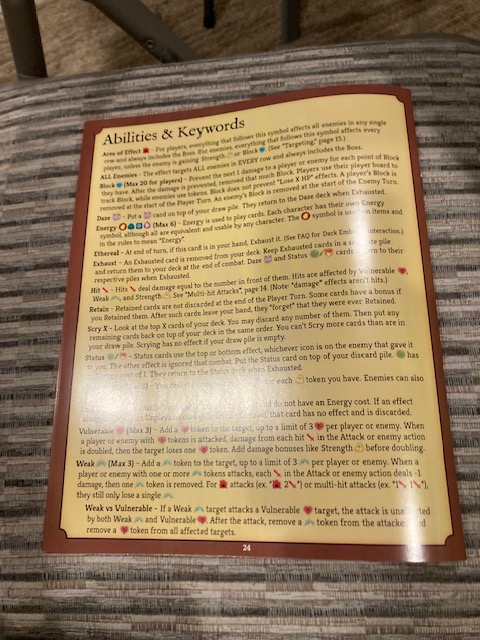
Even though this game doesn’t have an Index (and it really should), the back of the rulebook had an invaluable list of Abilities and Keywords.
Don’t get me wrong, there’s a lot of good stuff in the rulebook, but it was too minimal in a few places (For example: a few more sentences about the Retain keyword or why Summon deck shouldn’t be shuffled). I was able to learn the game and playthrough solo … and I had fun. I was able to play cooperatively with a bunch of friends (who hadn’t played the Video Game) … and we all had fun. It wasn’t until I played with seasoned Video Gamers that knew the game that I realized this rulebook needed some more clarifications: it depended a little too much of knowledge of the video game.
Solo Game
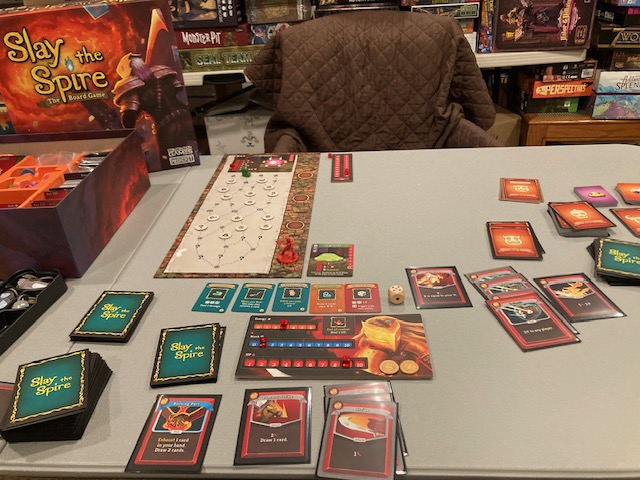
Like the Video Game, you can play this solo (thank you for following Saunders’ Law)! See above as I set-up the red guy for a solo game. There’s not really a lot of special rules or exceptions for the solo game, you just play! The main balancing mechanisms are really in combat:
- In plain combat, a monster comes out per row (i.e. per player). Thus, the solo player will be fighting just one row of monster(s).
- In Big Bad combat, the number of hit points is scaled to the number of players.
So, in general, you can just jump in and play the solo game without any real special rules! Thank you Slay The Spire! It was SO EASY to jump in solo!

I had so much fun playing solo that I played through the first three Acts of the game! I had a blast! There are so many places where you upgrade or get new cards, that you always feel like you are making progress! You always feel like you are getting better!
Really, solo was fun. I had a blast. I played wrong on a few points (one to discuss below), but even without knowing the Video Game, I had a good time.
Cooperative Play with Players Who DO NOT Know the Video Game
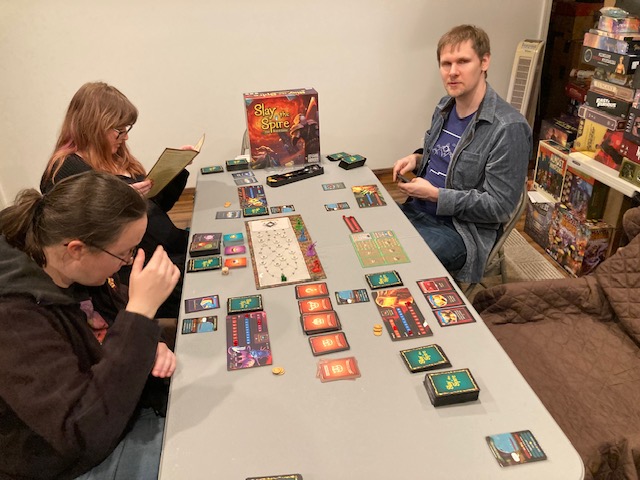
I ended up playing a full 4-Player game of Slay The Spire with three of my friends who have never played the Video Game! We ended up playing through Act I in one night in about 90 minutes (with a little extra time for set-up and tear-down). So, I just had to teach the game as-is … no one (including myself) had ever played Slay The Spire the Video Game!

The biggest conceptually difference, of course, is that this is a fully cooperative game! Slay The Spire is always thought of as a solo game! But the board game is fully cooperative!

The biggest change is that every character gets his/her own row of monsters to fight! See above! While you nominally tend to fight the monster in your row (it sort of becomes “your responsibility” as it does damage to you only), you can target any monster in any row! So, if a monster has a particularly bad effect for everyone (certain monsters can attack everyone), or if a comrade just needs a little help, players may choose to work together to take out particularly vexing monsters!

My favorite rule in this game is that it allows fine-grained Player Selected Turn Order (see more discussion of PSTO here). The rulebook calls this out on page 12:
“Players can play cards, use potions, and activate abilities in any order they choose.”
What this means, is that we (as players) can intersperse our actions to accomplish things! If we need Sara to play a Potion, then Andrew attacks to add a Vulnerable, to which then Sara can play another card and attack (for double damage), we can do that! Players can work together to find the best combination of their interspersed actions to take down the baddies!
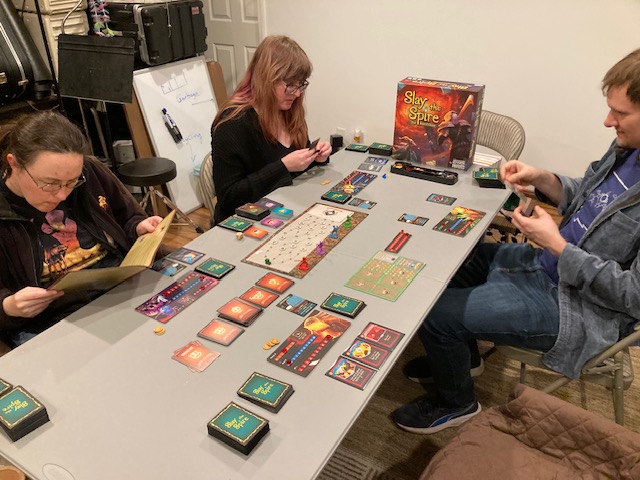
In fact, in some ways, Slay The Spire gets the best of both worlds! Since you “generally” need to fight the monster in your row, players can do Simultaneous Actions to fight their own monster, but defer to fine-grained Player Selected Turn Order if they really need to! The Simultaneous Actions helps keep everyone involved … rather than waiting for “your turn”, you can all fight the monsters at once … this means there is much less downtime.
I think this is where Slay The Spire shines the brightest as a cooperative game: the players can choose the best way to play to either help each other (with fine-grained Player Selected Turn Order) or move the game along quickly (with an easy way to Simultaneous Actions fighting your monsters!) It’s the player’s choice, and I noticed we shifted between these modes pretty seamlessly when we played! It was something I didn’t notice until I looked back on our plays.
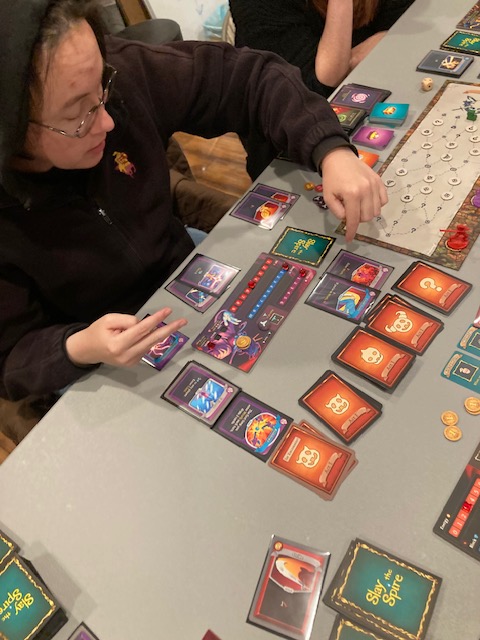
The cooperative game worked fantastically, probably better than the solo game because I got to talk and strategize and have fun with my friends!
Cooperative Play With People WHO HAVE PLAYED The Video Game
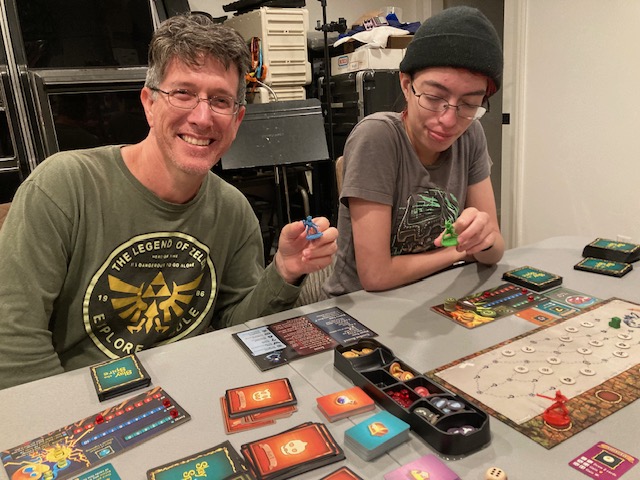
So, I wanted to make sure I played this game cooperatively with some friends who have played the video game: I wanted to see what they thought. Jon and Keala (above) are both fans and have played (and like) Slay The Spire the video game.
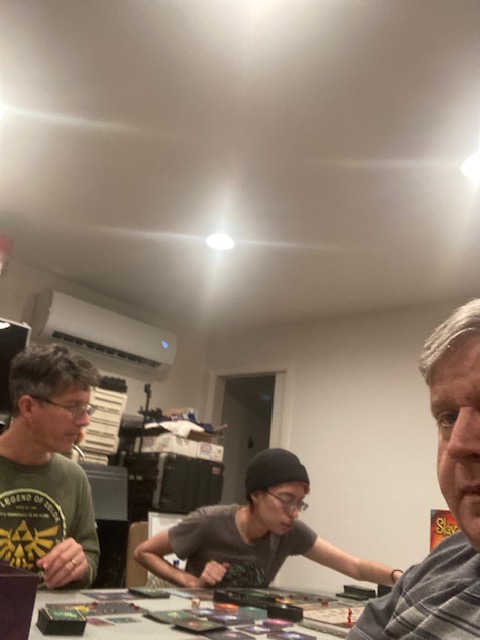
What happened sort of surprised me: we fell into a rhythm fairly quickly. Every time there was any rules question, Jon or Keala spoke up and said “Well, it’s like this in the video game”, so we didn’t spend very much time pouring over the rulebook. The Video Game became the reference implementation of the game! This was both cool and annoying. It was cool that the game seemed to fall inline with the Video Game, but it was annoying that the rulebook didn’t do better at explaining a lot of things.

We had so much fun playing, we ended up playing Act I and Act II in one night! The game just seemed fun to everyone.

Jon saved our bacon a number of times: he had the ability to shield other players (as the blue guy), which worked out very well! I would be able to attack something (as the red guy) and Jon (as the blue guy) would shield me or Keala (the green guy) so that we wouldn’t die! This cooperation seemed seamless! It just happened that way!
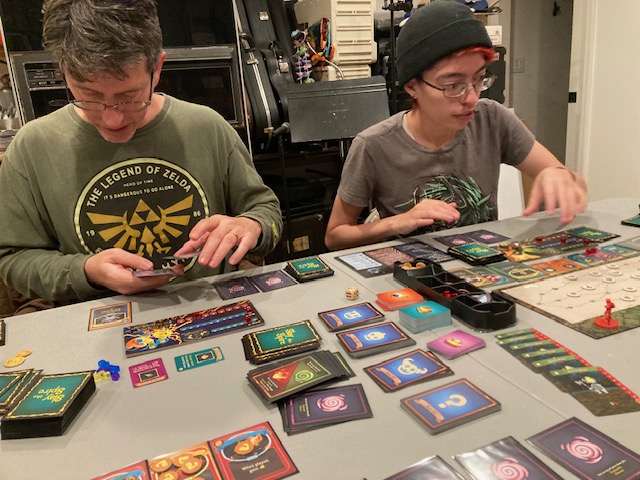
The game really clicked for everyone that night: I feel like I know the game better (with all my friends’ comments on how the Video Game works), and I was able to bring my friends into the card game quickly from reading the rules. We had a great time and plan to play again!
A While

It’s taken a while for me to get to this point. I initially had some misgivings about the game.
At first, I was grumpy at the rulebook for how minimal is was: it really needs a lot more elaborations on the rules. There was one rule in particular I was enchanted with, until I realized I was playing wrong. The “Draw 5 Cards: there is no maximum hand size” (p. 12) lead me to believe that maybe I had more choice of which cards I could discard. Maybe I could keep cards between hands? Why else would you emphasize this rule of no maximum hand size? Jon and Keala had to tell me this, but you always discard all your cards!! All of them! … just like in the video game. (to be fair, it is in the rulebook but it is one sentence). I think that rule is there to show that during your turn you can draw as many cards as you want.

Another thing that threw me off for a while was the art. I had just gotten a new deck-building expansion for Thunderstone Quest (see art above), and the art and graphic design for Thunderstone Quest (above) is significantly better than the art for Slay The Spire (below).

Comparatively, the art for Slay The Spire is a little anemic after looking at Thunderstone Quest. But I seem to be the only one who doesn’t love the art. I will admit, the art for Slay The Spire has grown on me a little: it’s very simple and not too busy. It’s also very readable. But since I have never played the original video game, I was not as “enchanted” with this art as others.
Flaws
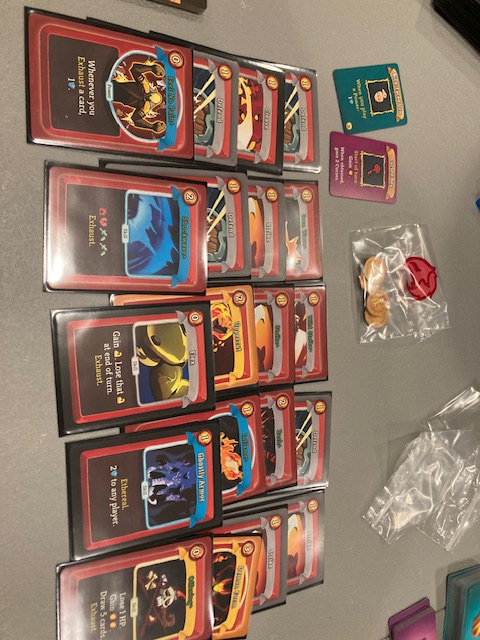
This is a funny flaw in the game: you can’t (easily) have multiple games going on! You can save your game fairly easily (putting the appropriate cards in the appropriate slots), so you know you can come back and do another session. The problem is, if you want to play another game, you can to reset ALL THE CARDS for each deck!! We worked around it by taking pictures of our decks: if worse comes to worse, we can always use the picture of all our cards (see above) to recreate our save game. I suspect many people will want to try this game, and we won’t be able to easily have many games going on. In some ways, this is a product of its own success: it’s so much fun, people want to try it! But, be aware that a single game is easy to save, multiple games will require taking pictures of all your cards. And also the Unlocks sheet (see below) .. which presents more issues.
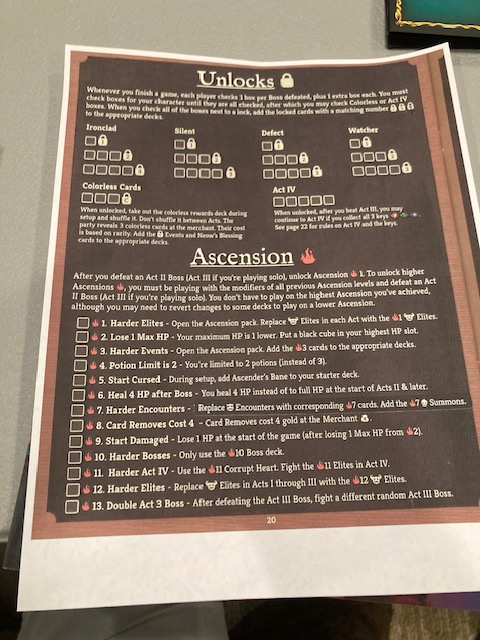
Another problem with this game is it’s really unclear how you move on once you play through Acts I, II, and III. The Ascension decks (see above) add some variety and keep the game interesting, but it’s kind of unclear how this fits in. Do you start a new game at Act I with the changes? Do you start a new deck? To play Act IV, you have to unlock it, but are you playing Act III again and again and again? Like everything I have seen in this rulebook, I wanted more elaboration! This rulebook frustrates me! Give me an example, give me a few more sentences, give me a page! I have played a solo game all the way through Act III. What do I do now? Add Ascension cards? Start over at Act I? This is very unclear!!! This is probably my biggest ding against the game: I don’t know exactly how to move forward. Sure, I suspect I will post to BoardGameGeek and someone will respond, and I will be able to move forward. But this rulebook does not make it clear how to move forward after Act III. UPDATE: I had lunch with my friend who has played the Video Game. He told me that in the Video Game, you just reset everything (including you deck) back to ACT I, but make a few cards (like the uncoloreds) available. I really DID NOT get that sense from the rulebook … another instant where knowledge of the Video Game helped and the rulebook didn’t.
Conclusion

Honestly, this Slay The Spire board and card game has really grown on me: I have played it solo numerous times, and I have shown it to many diverse game groups. The more I play it, the more I seem to like it! The upgrade paths makes this game great: there are so many opportunities to augment and upgrade your deck as you are playing! The fact that each players is so distinct in both powers and upgrades really contributes to how great this game is!

The production is fantastic, and the art is … thematic to the game. I have grown to appreciate the simple art and graphic design, but I still think the art and graphic design is a little anemic.

The solo game is great: it’s about an 8.5/10. It’s easy to play, and there’s really no exceptional rule changes needed to get the solo game to the table.
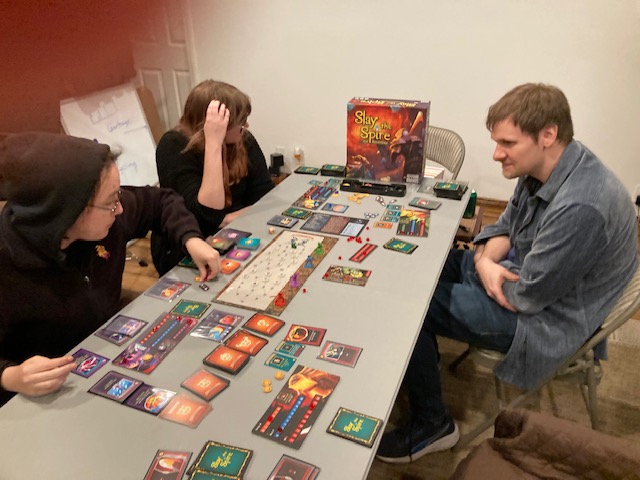
The cooperative game is about a 9/10: the base game is all there, with all the upgrade and augment paths, but the cooperation really shines brightly! Players can choose so many ways to help each other with fine-grained Player Selected Turn Order, with Simultaneous Play keeping everyone engaged at all times! And even though these play modes seem mutually exclusive, players seem to weave in and out of Simultaneous Play and PSTO without even noticing!

Players who know Slay The Spire the video game might find this to be a 10/10 for them: the game is great and also evokes so much atmosphere from the Video Game!
Over the course of many play sessions (both solo and cooperative), I ended up liking the game more and more. There are some issues with the rulebook, as it seems to assume players know Slay The Spire Video Game pretty well! Other than my issues with the rulebook, the game is great. Putting everything together, this feels like a 9.5/10 as an overall production! This game surprised me how much I liked, especially given my anti-Rogue-lite tendencies.
